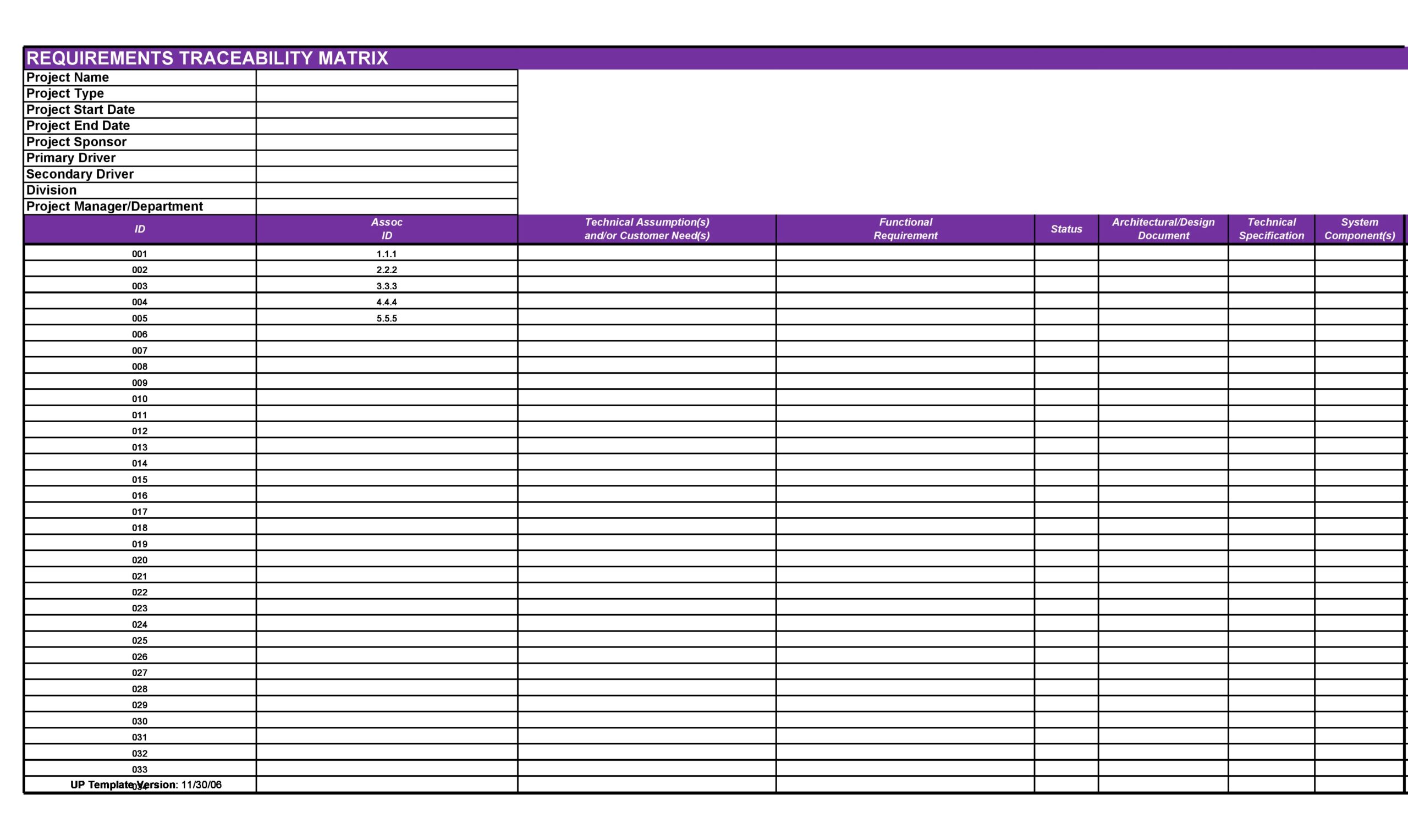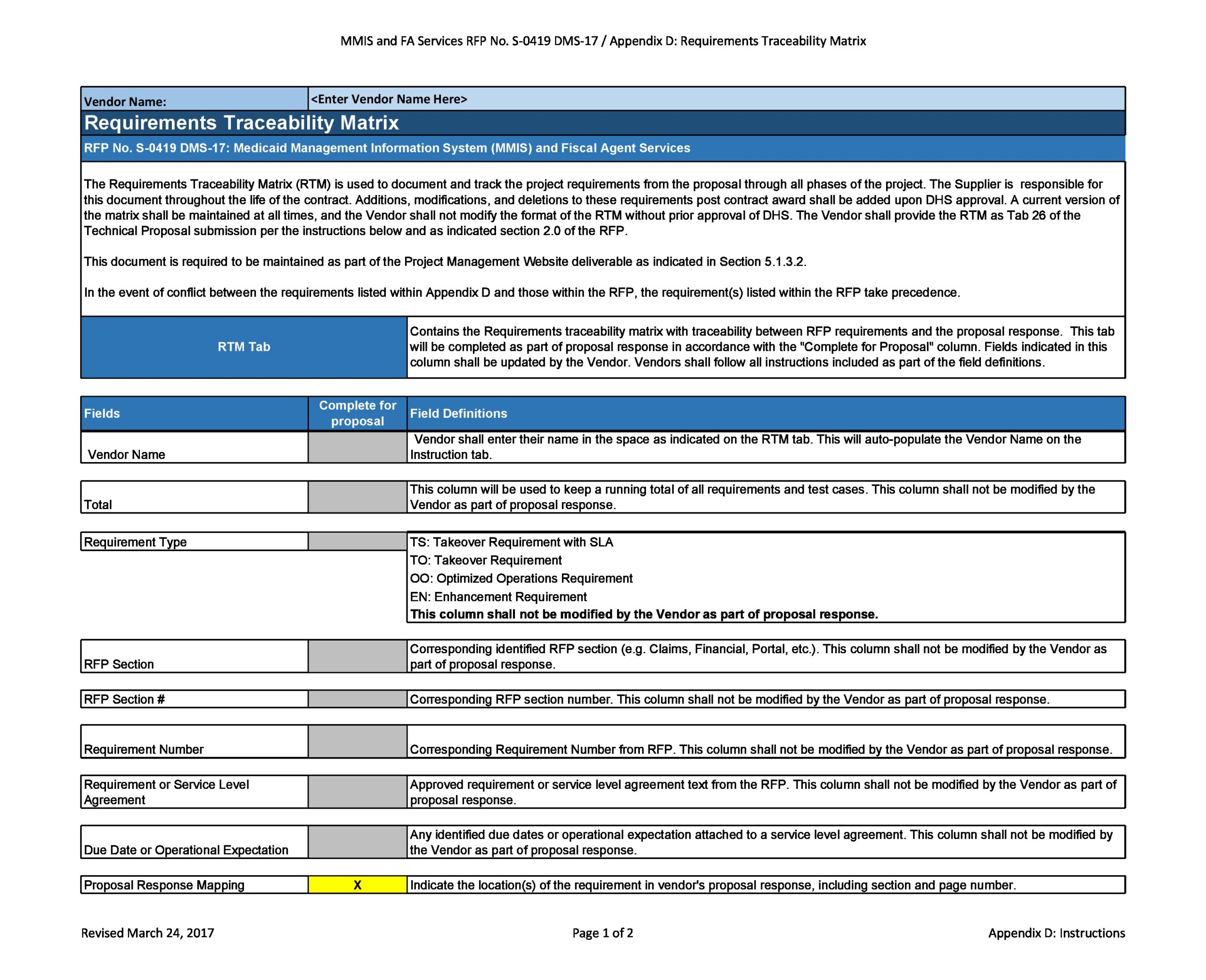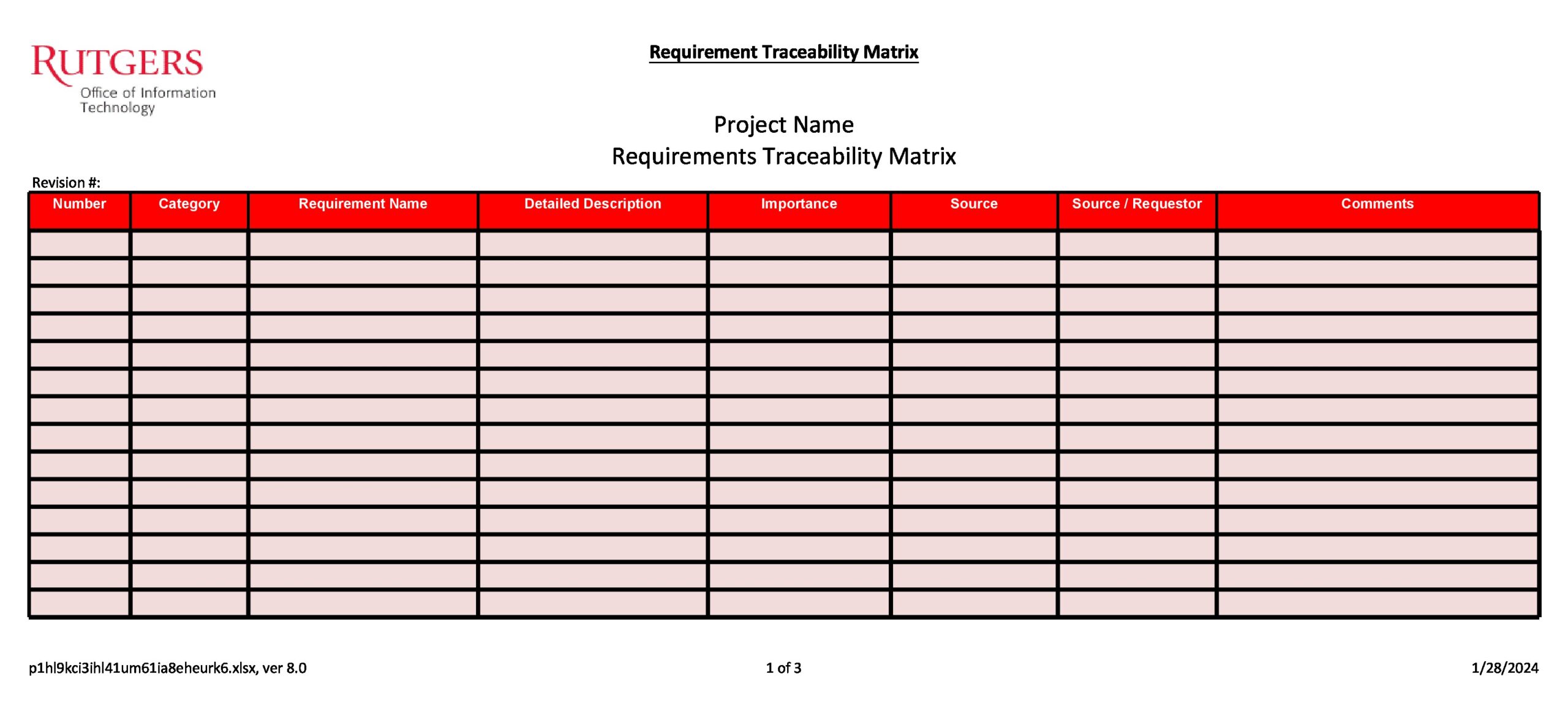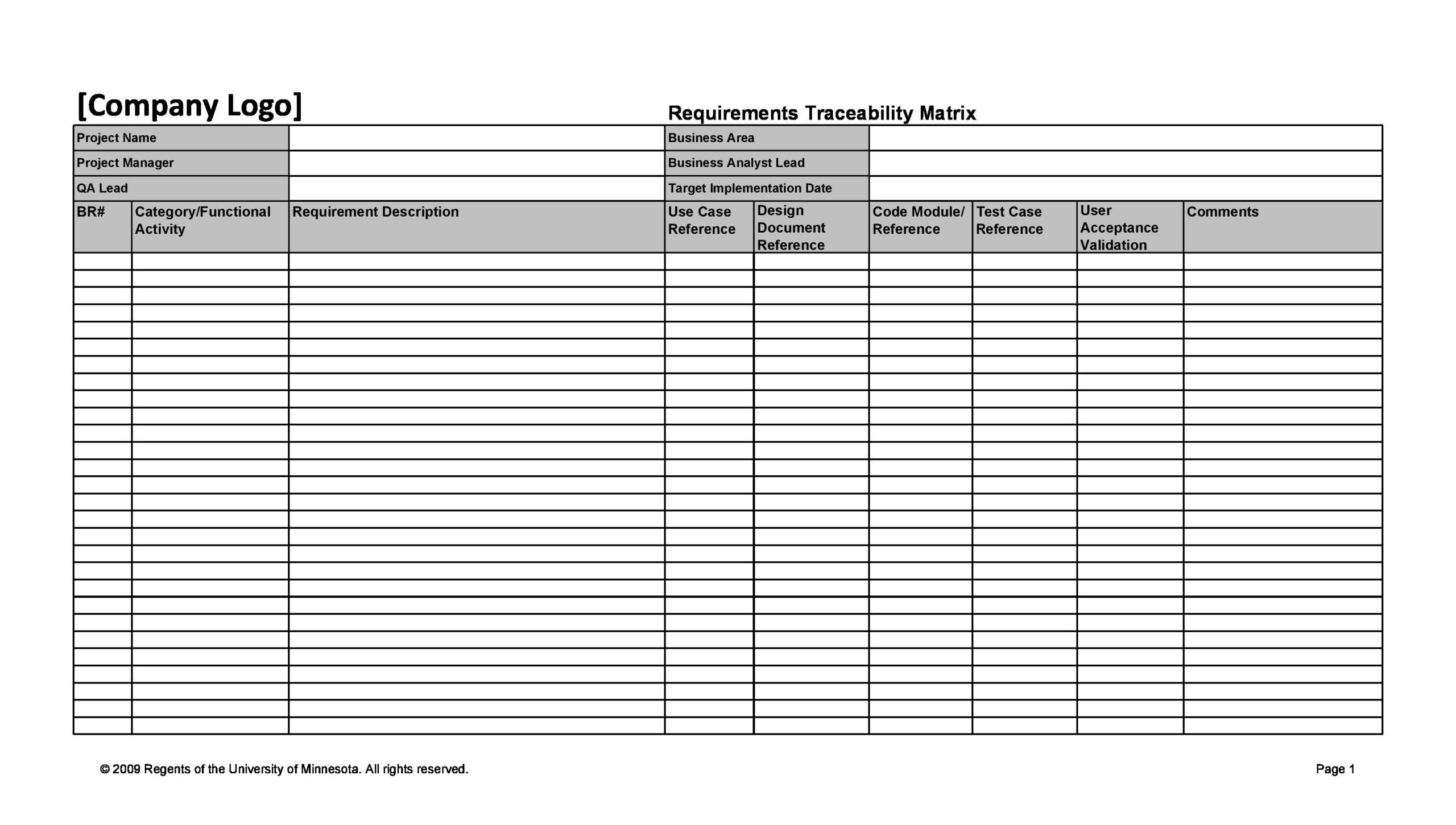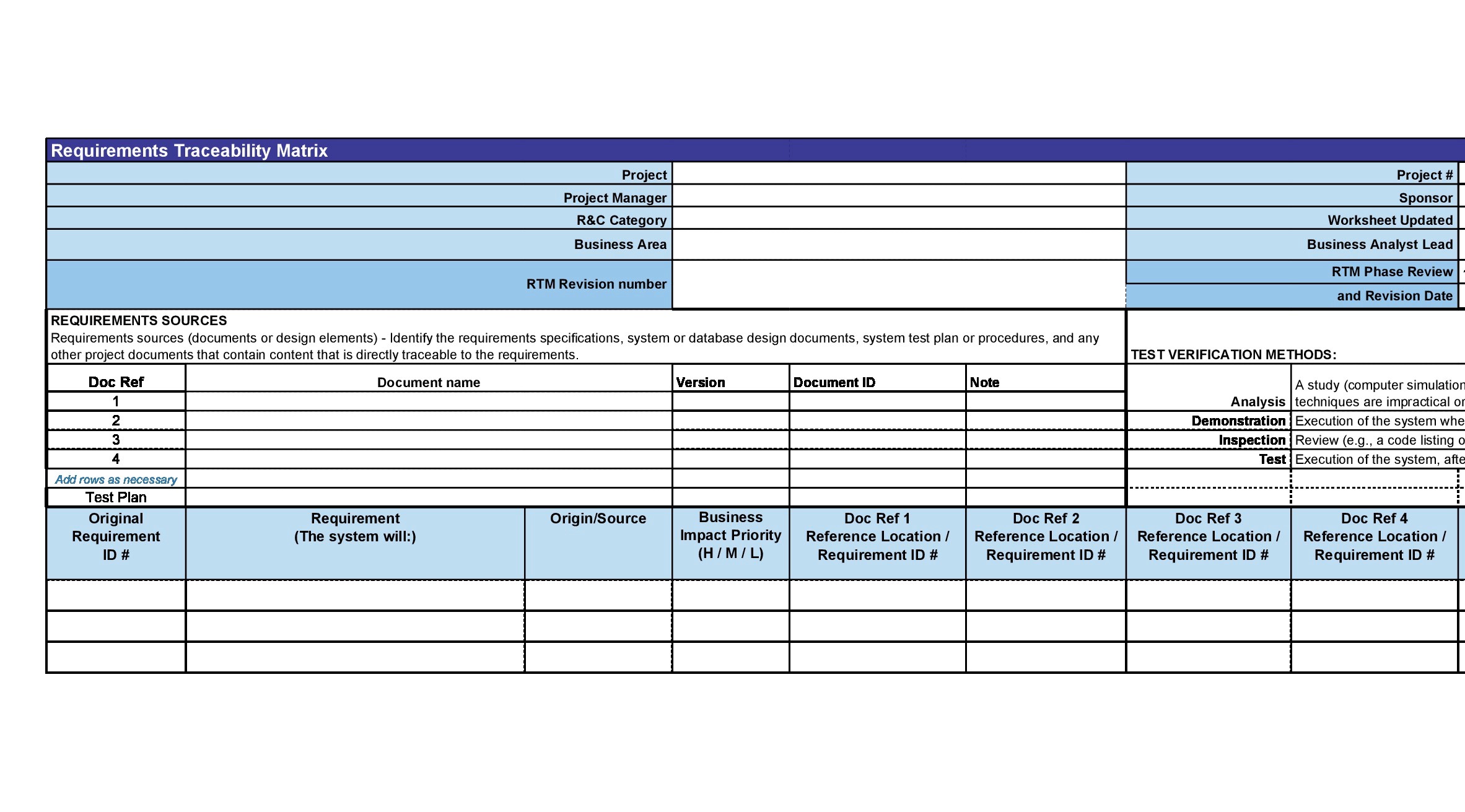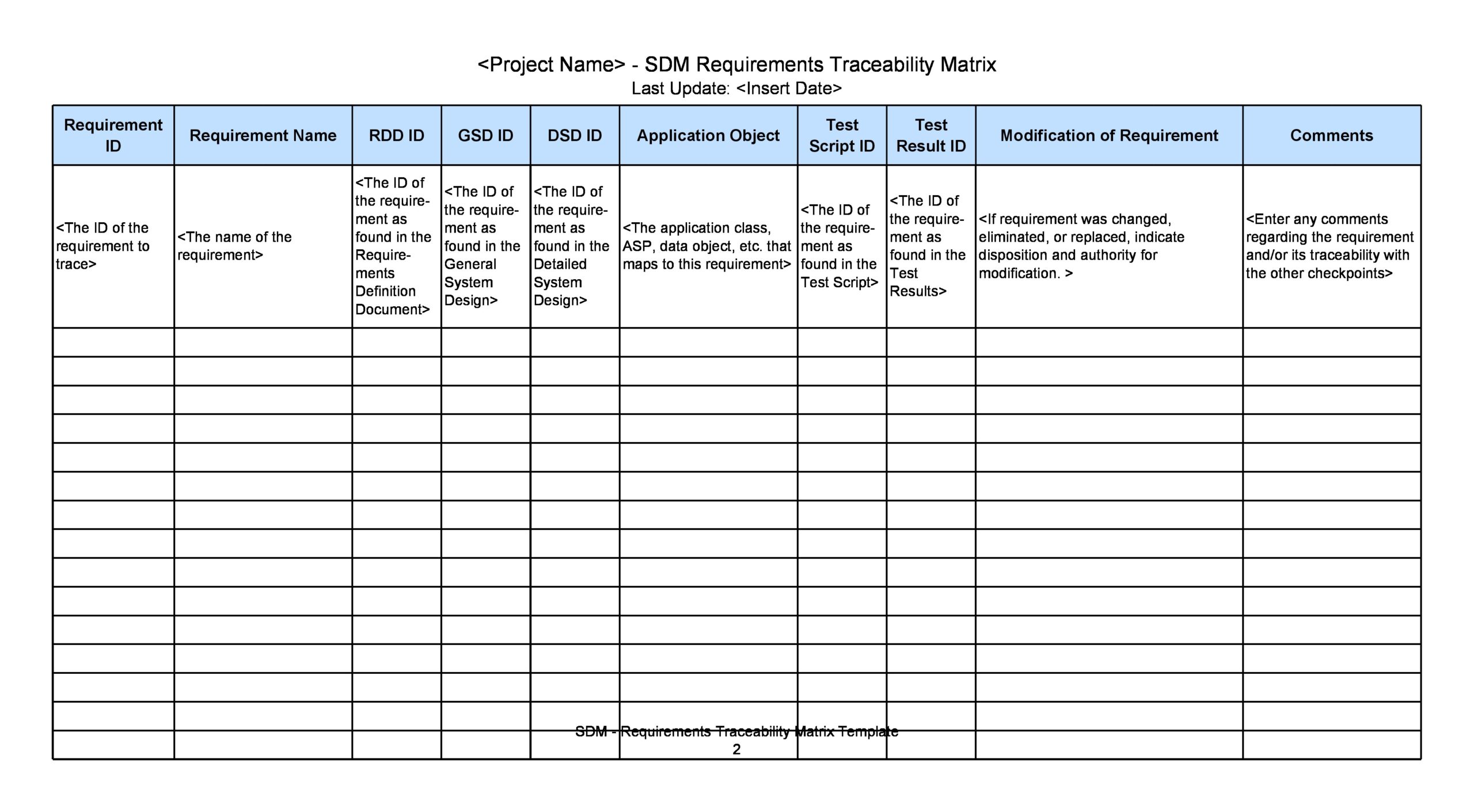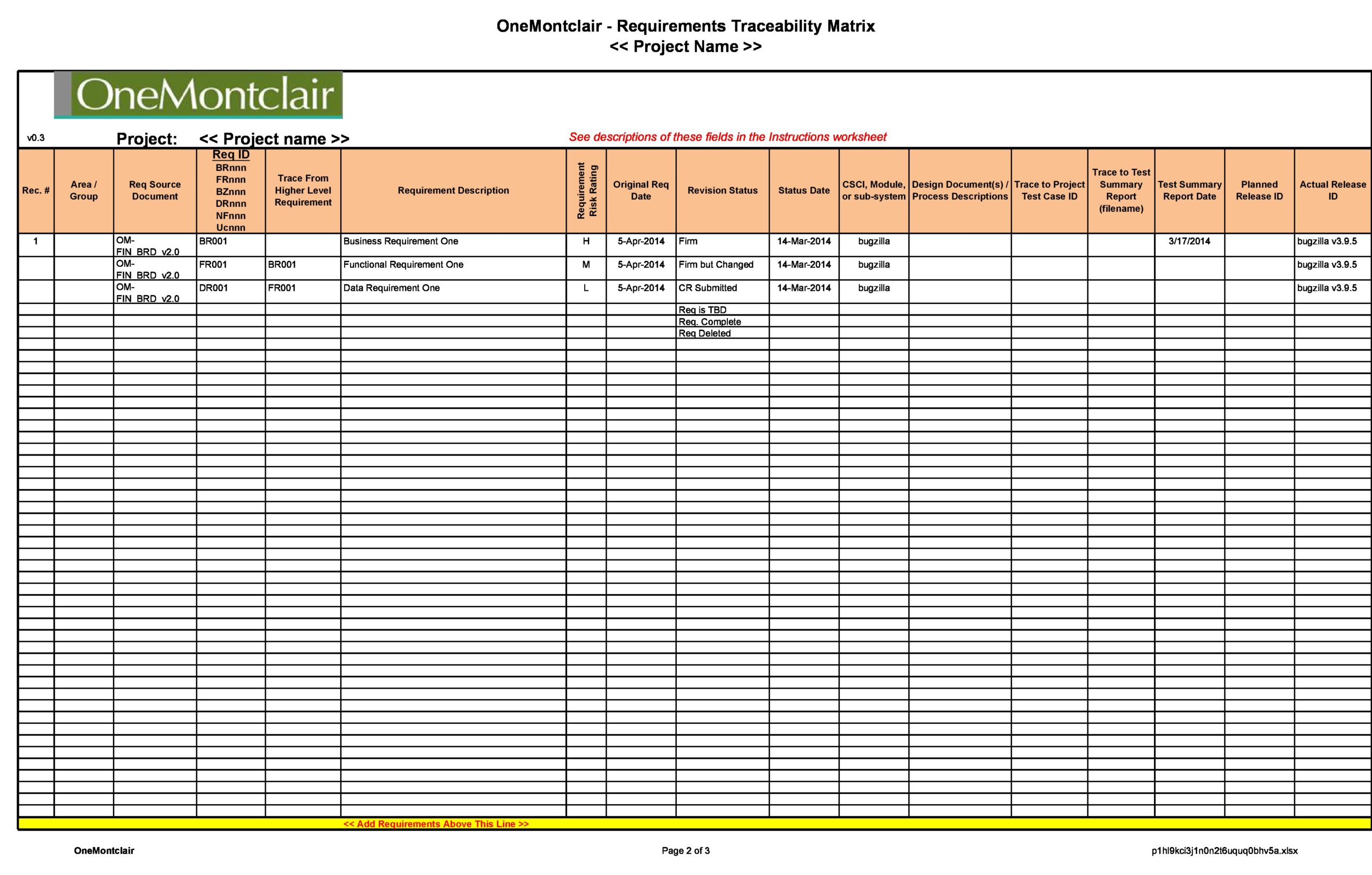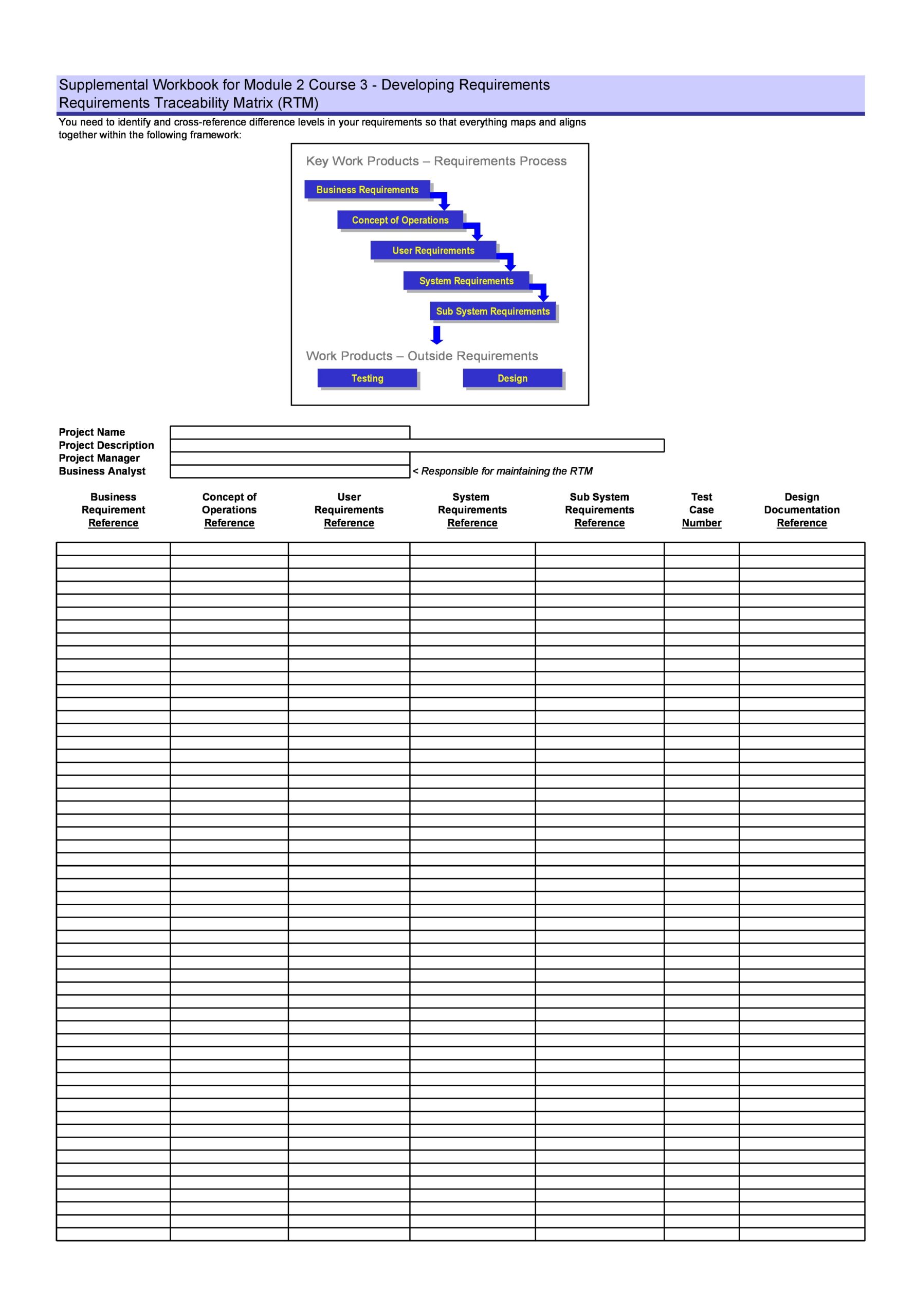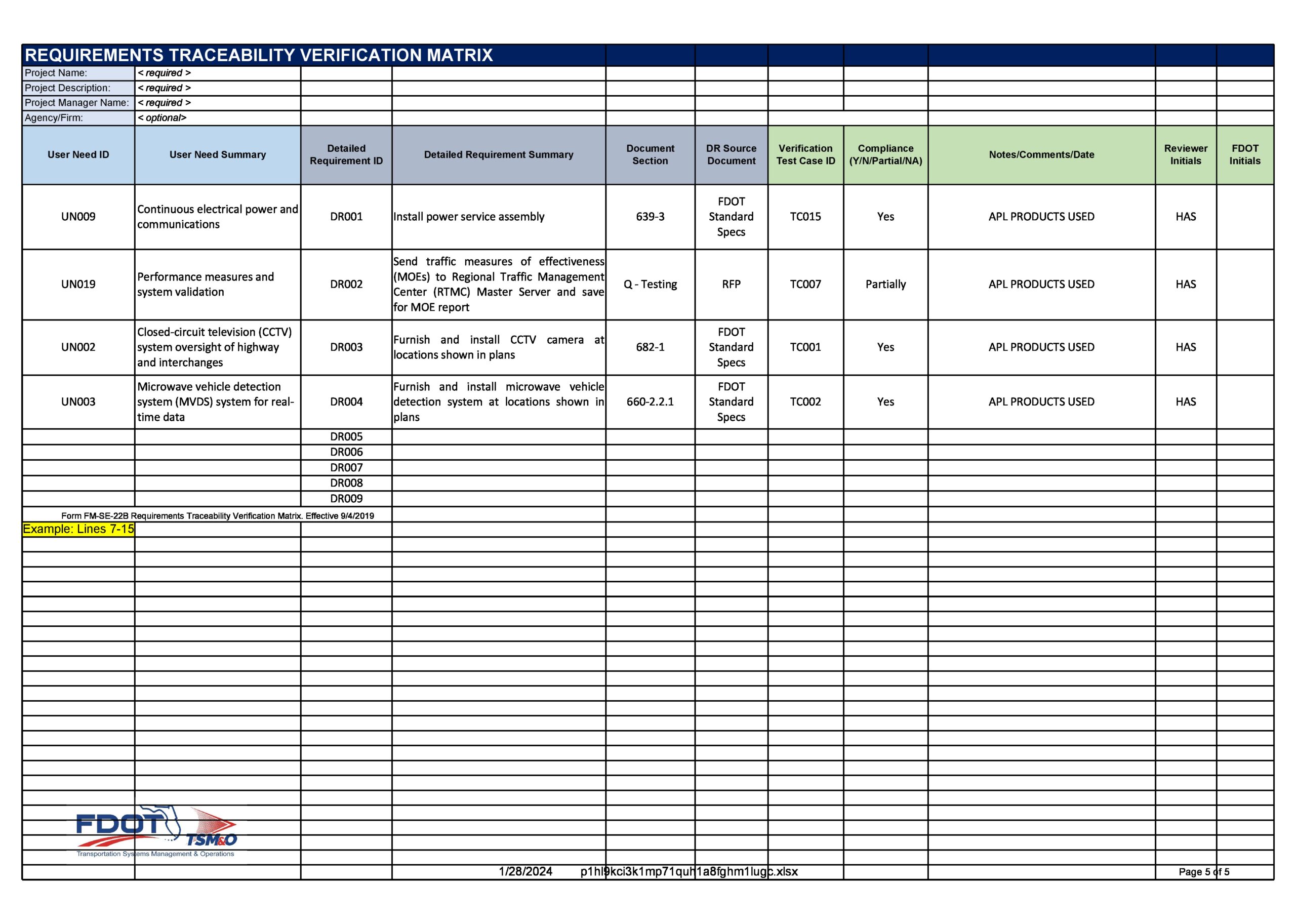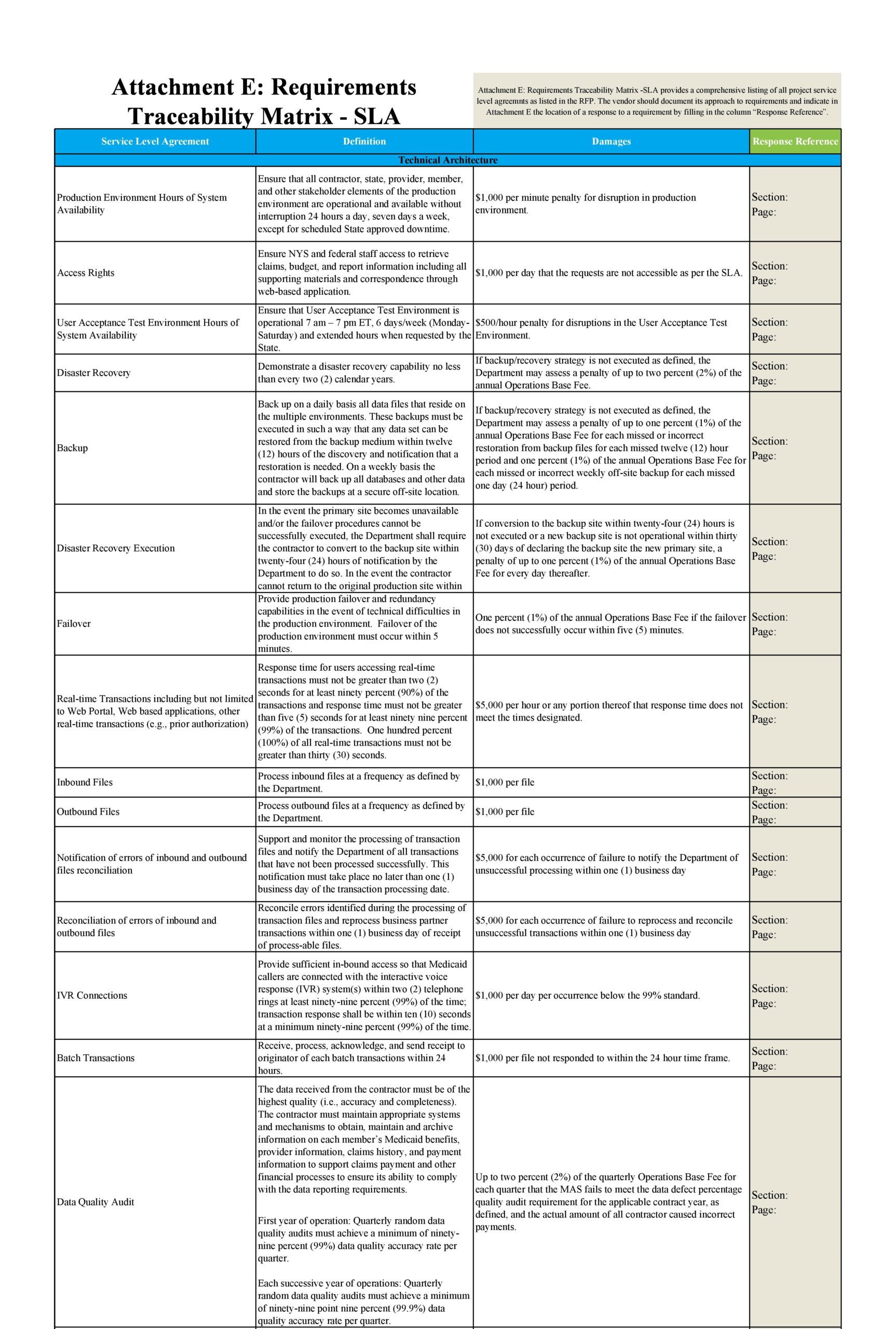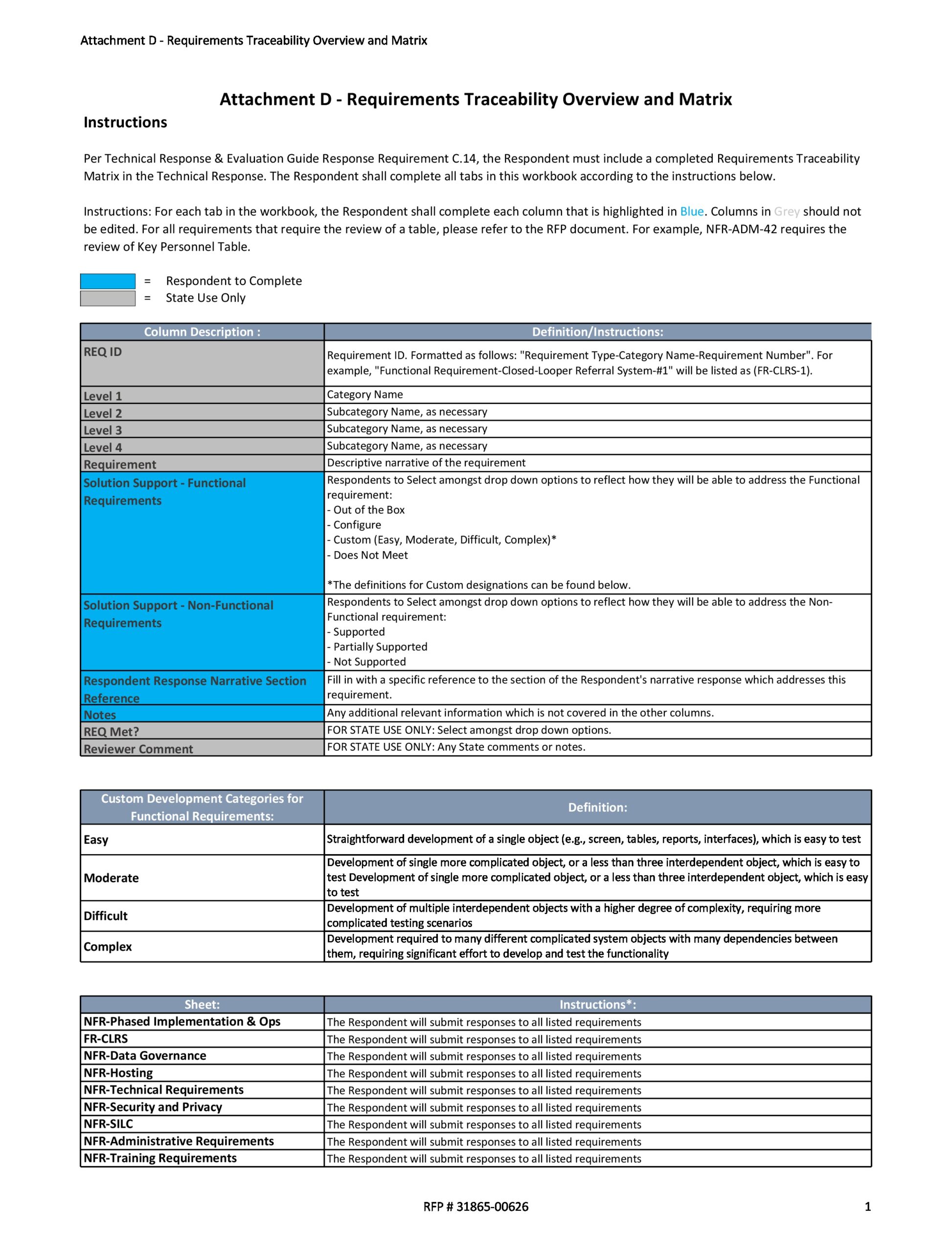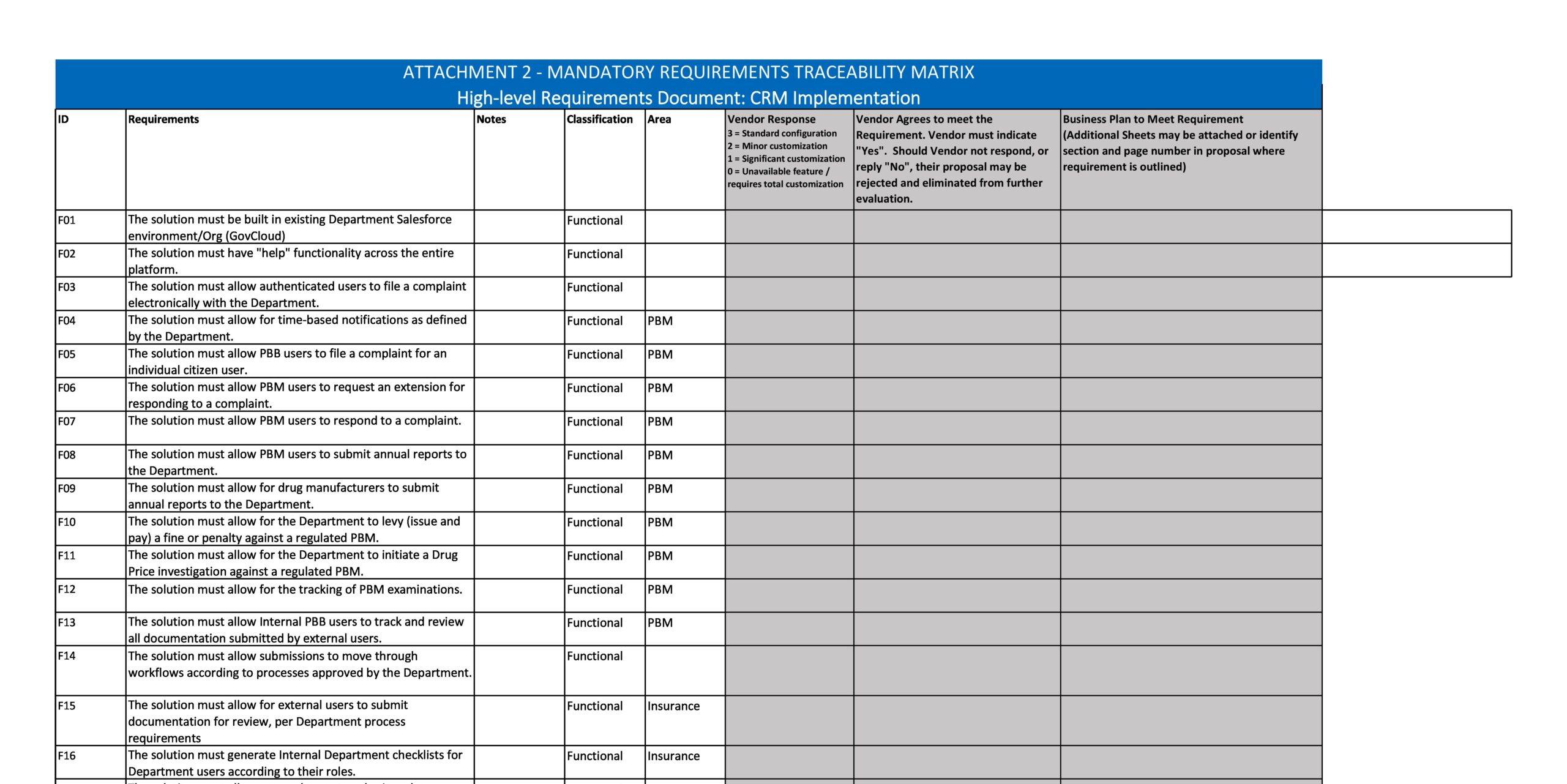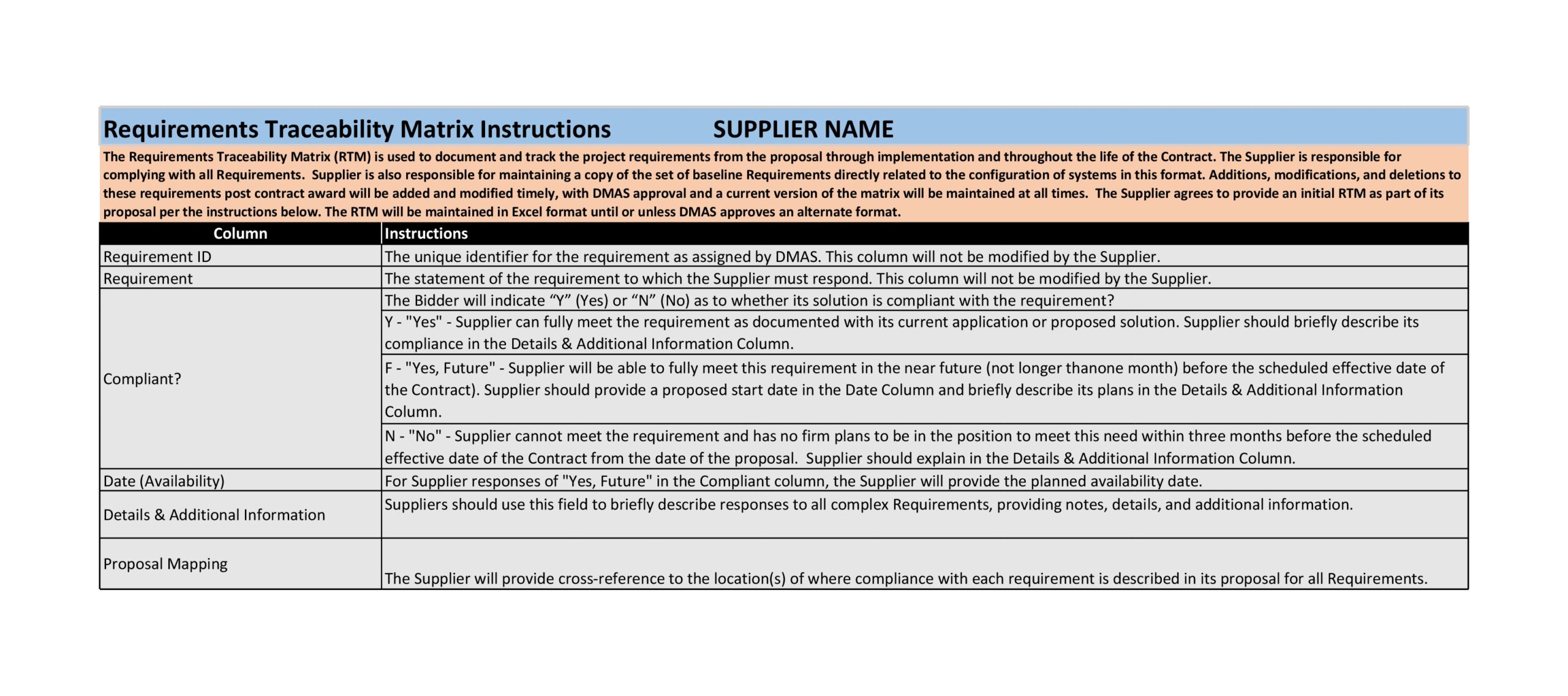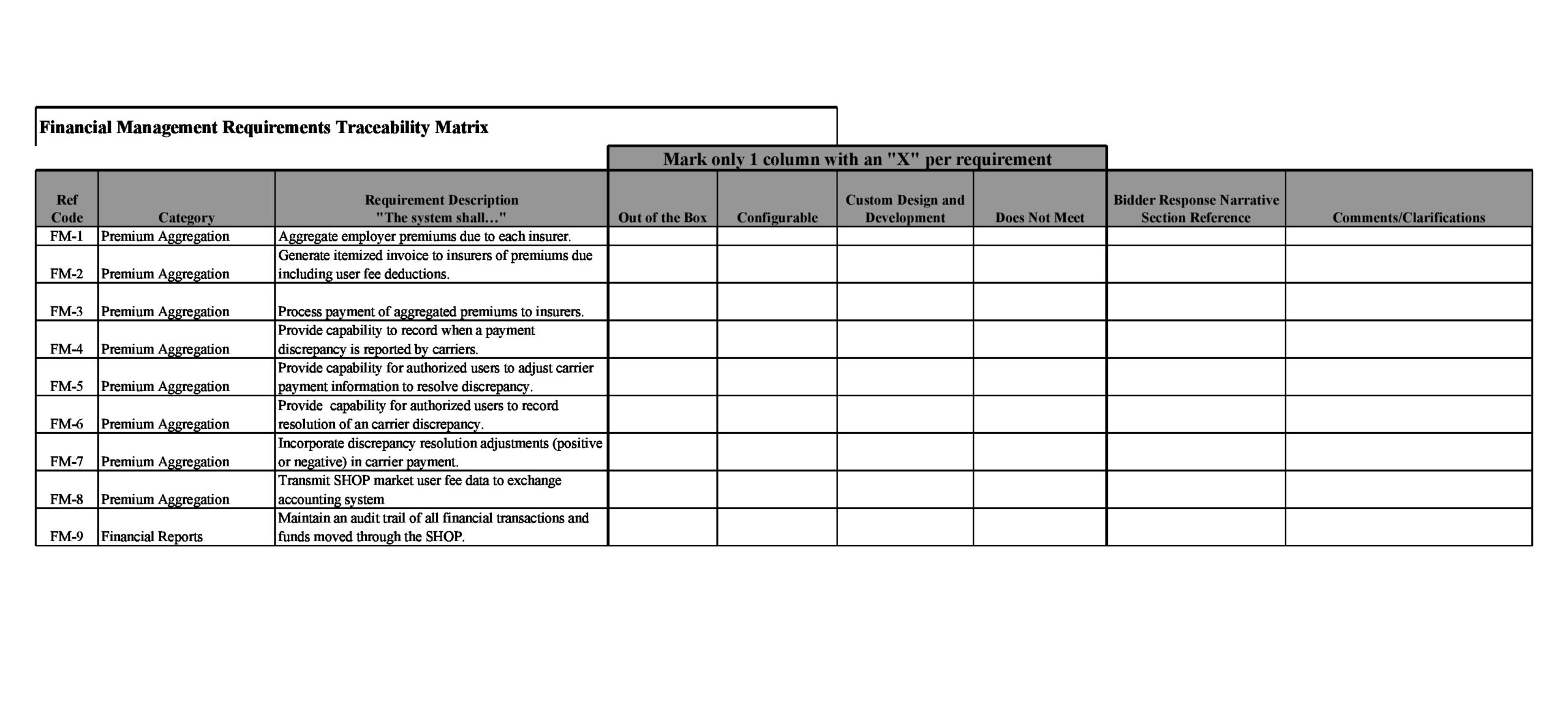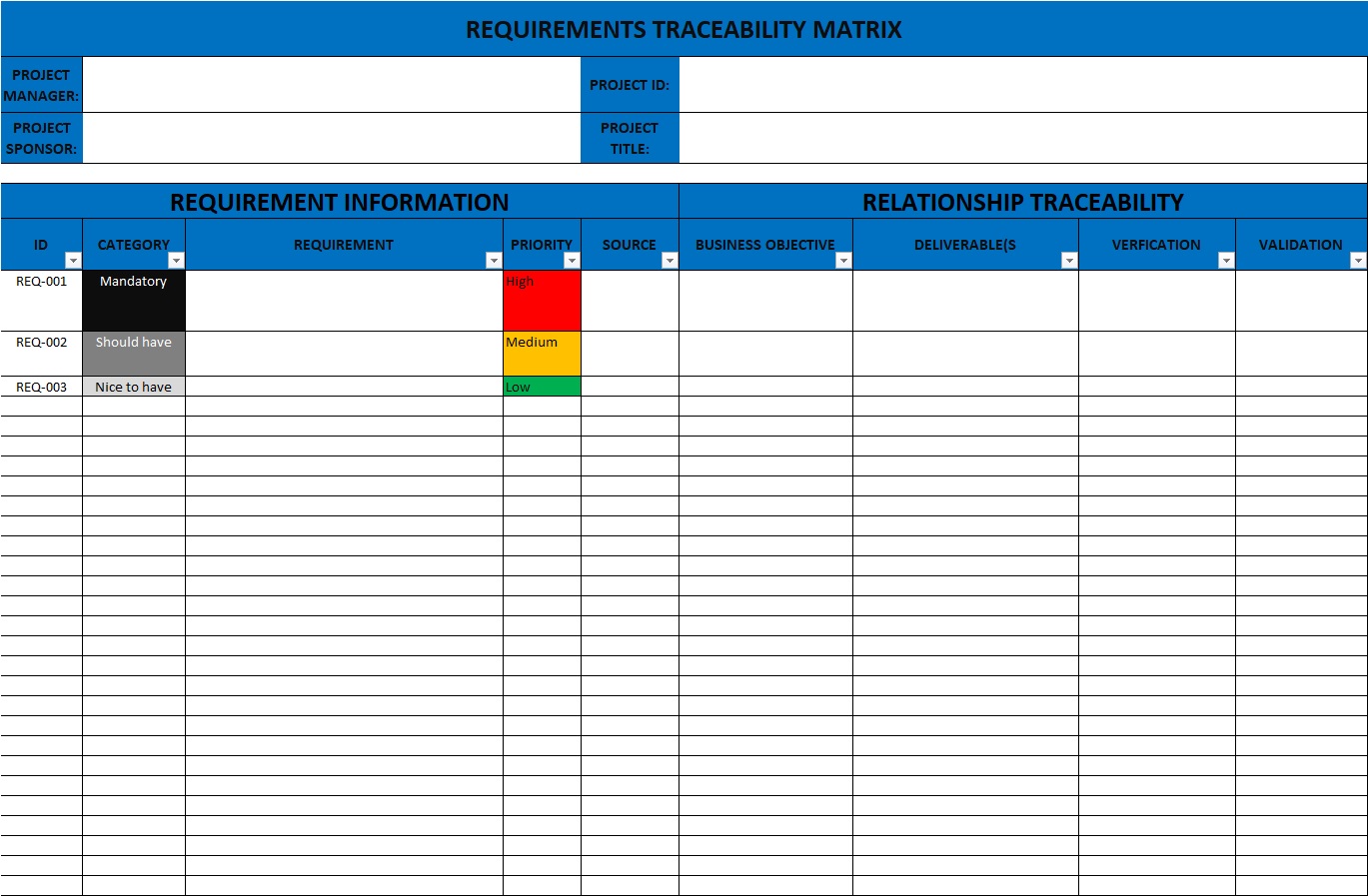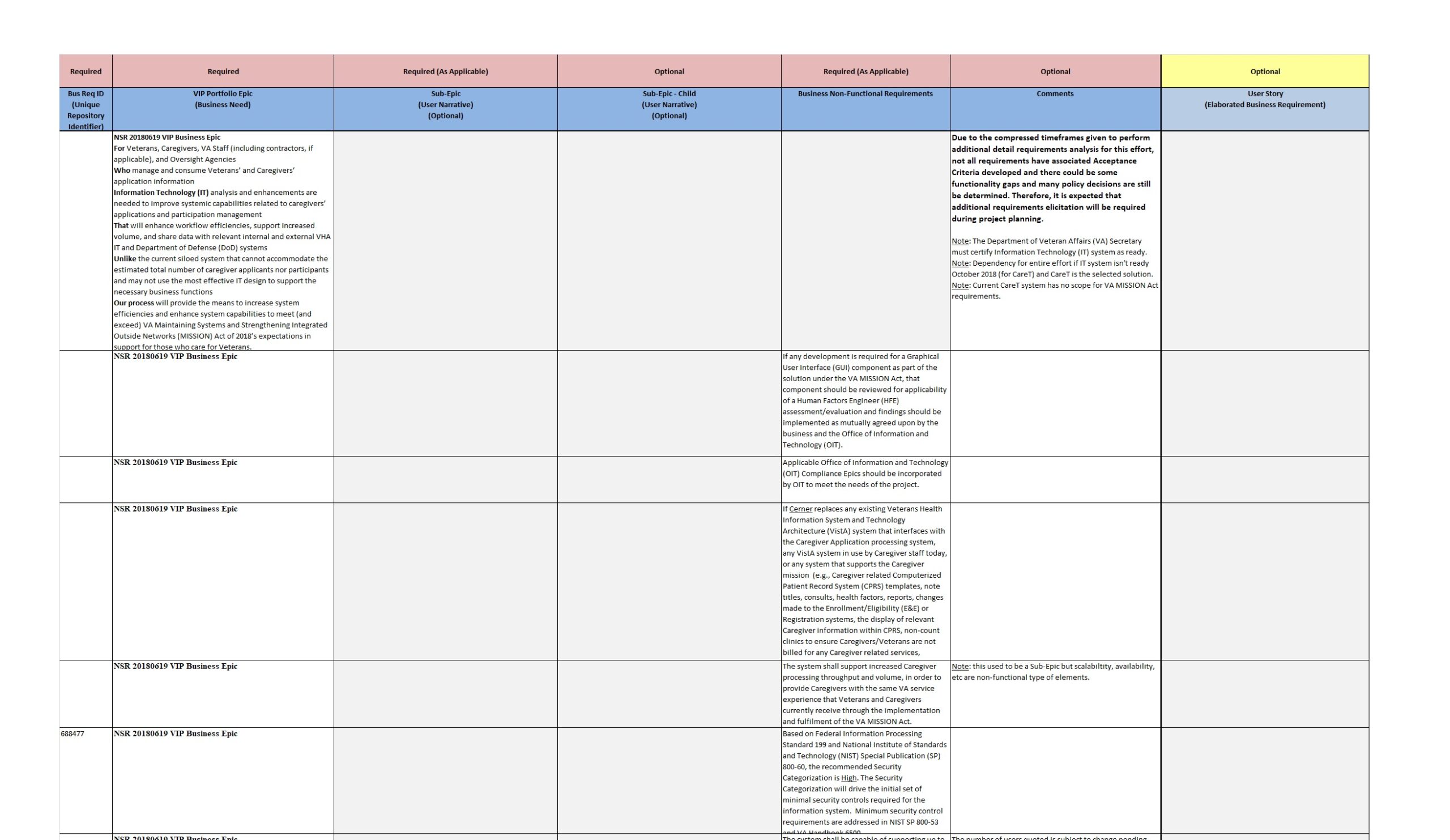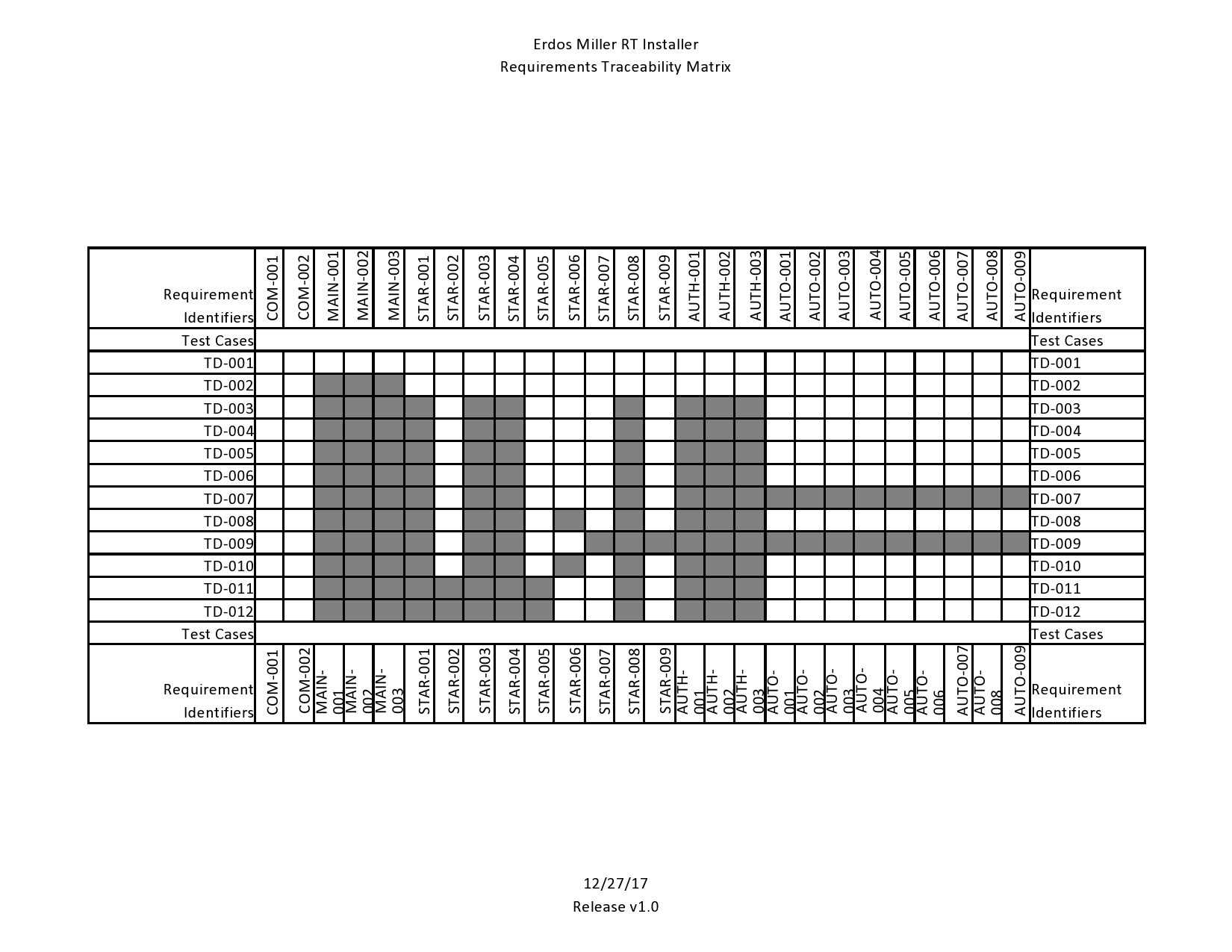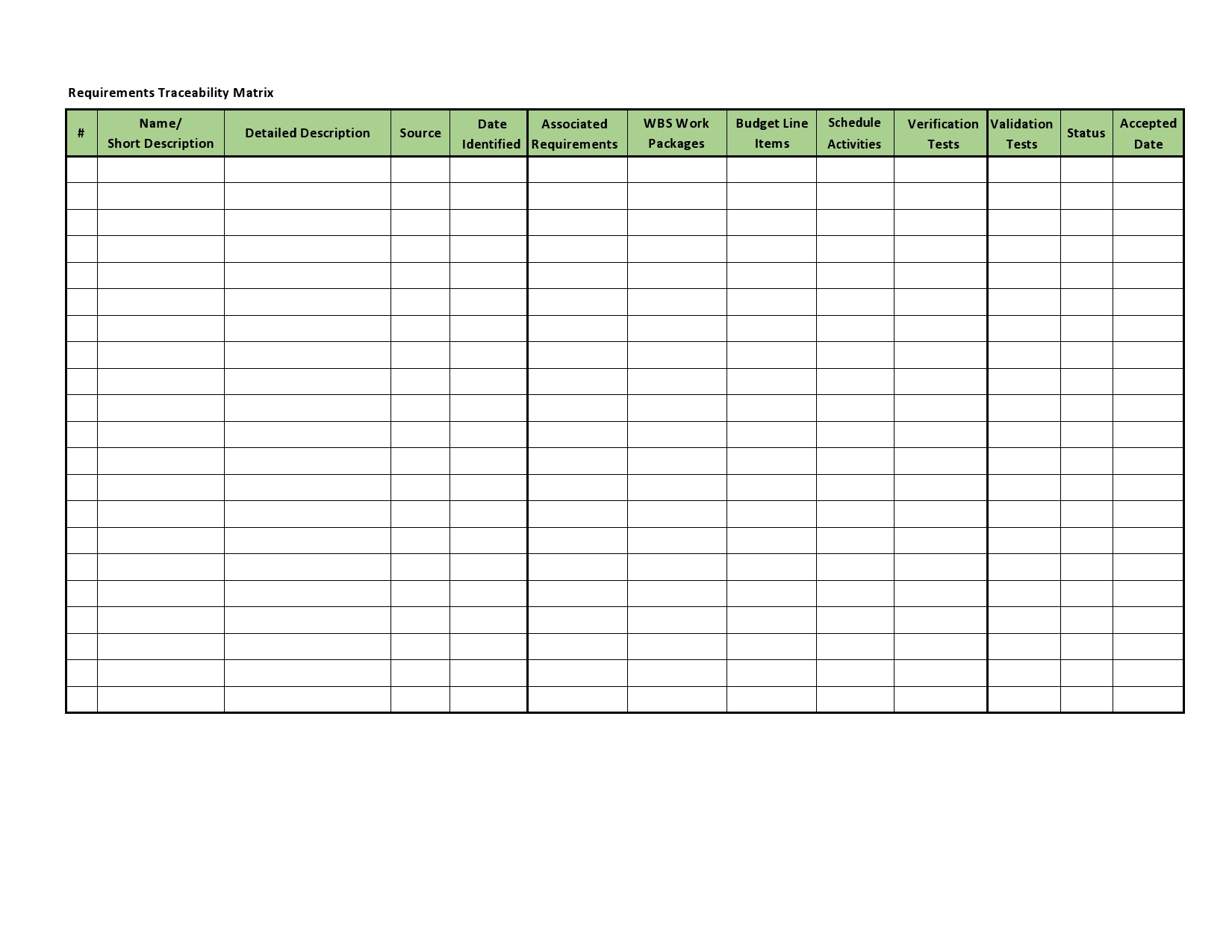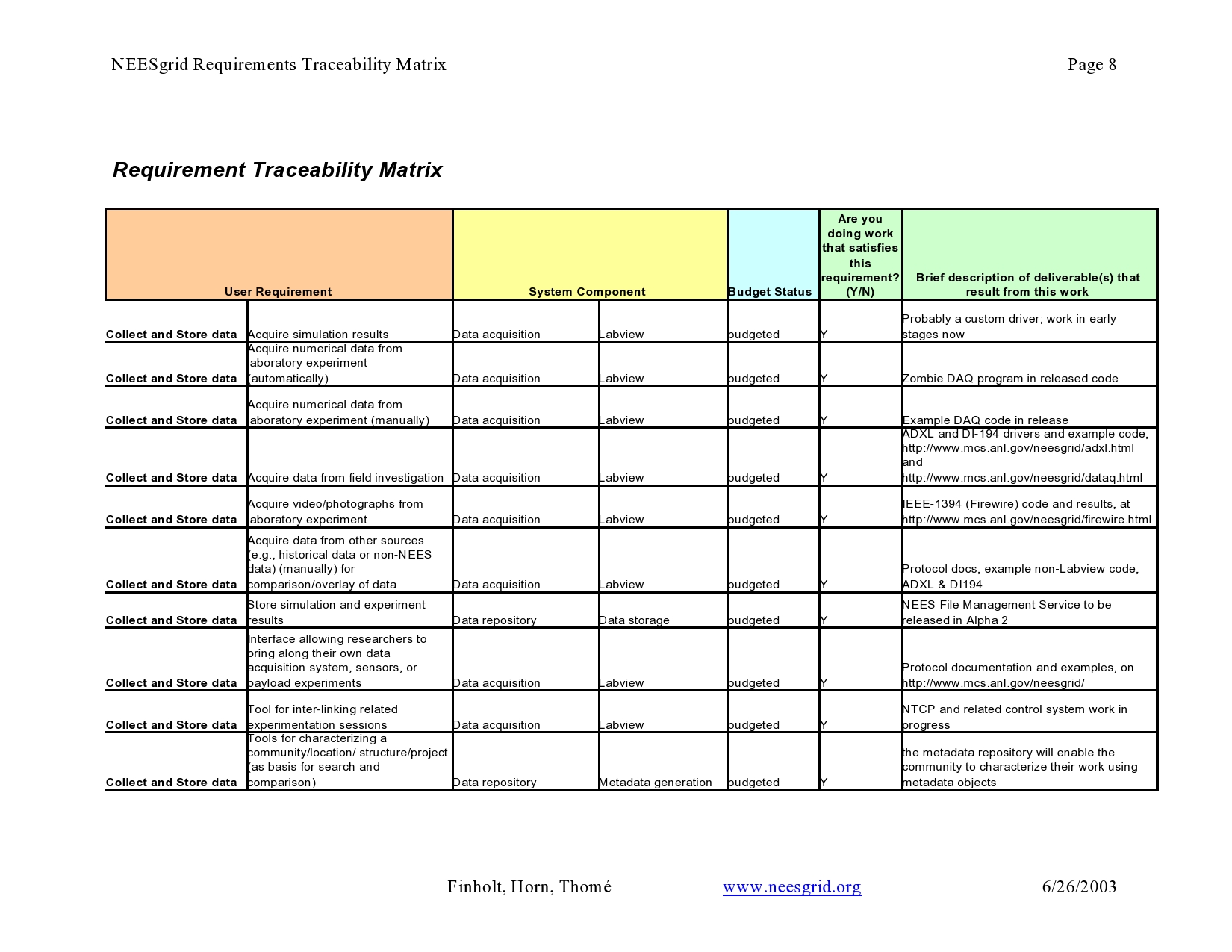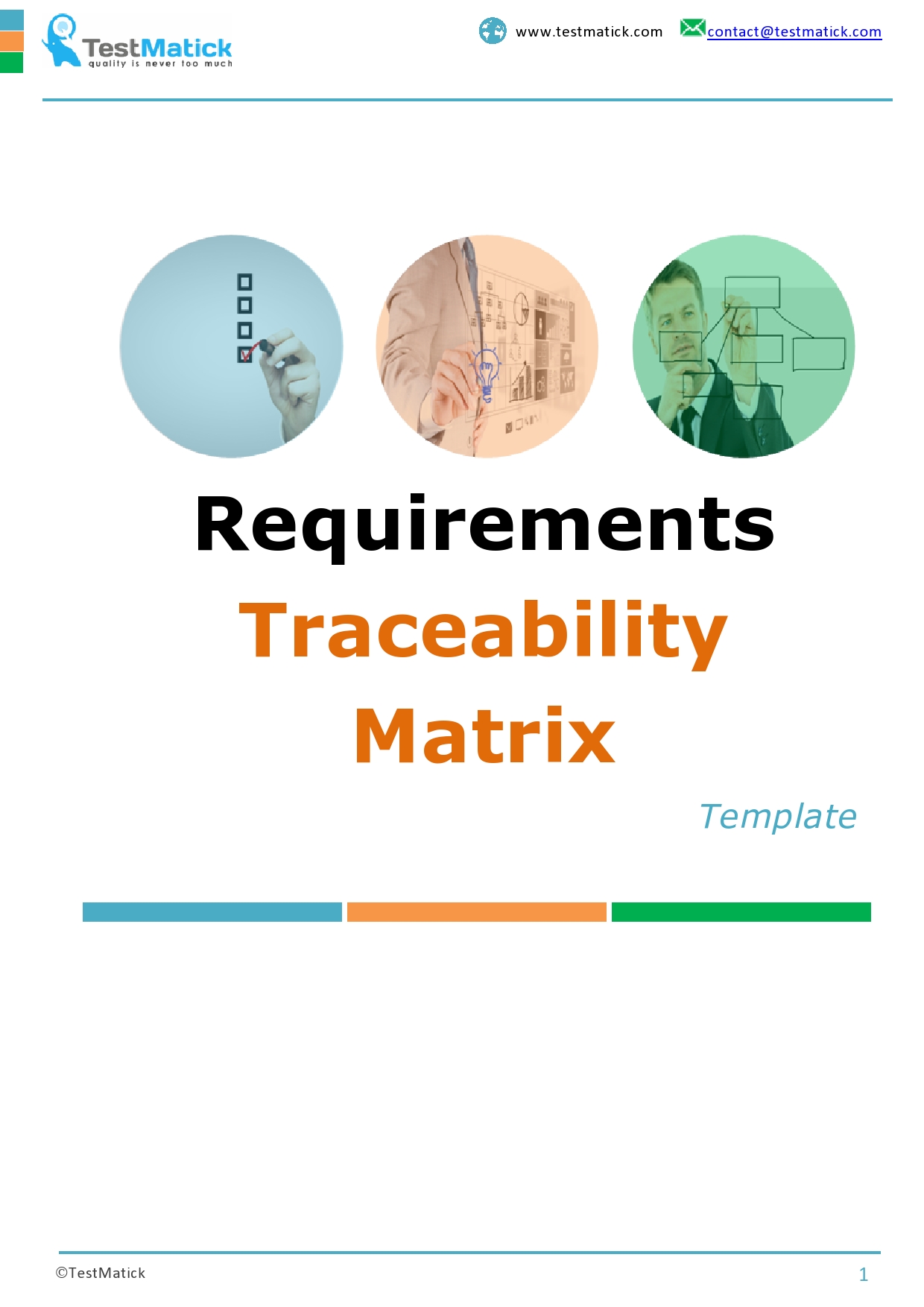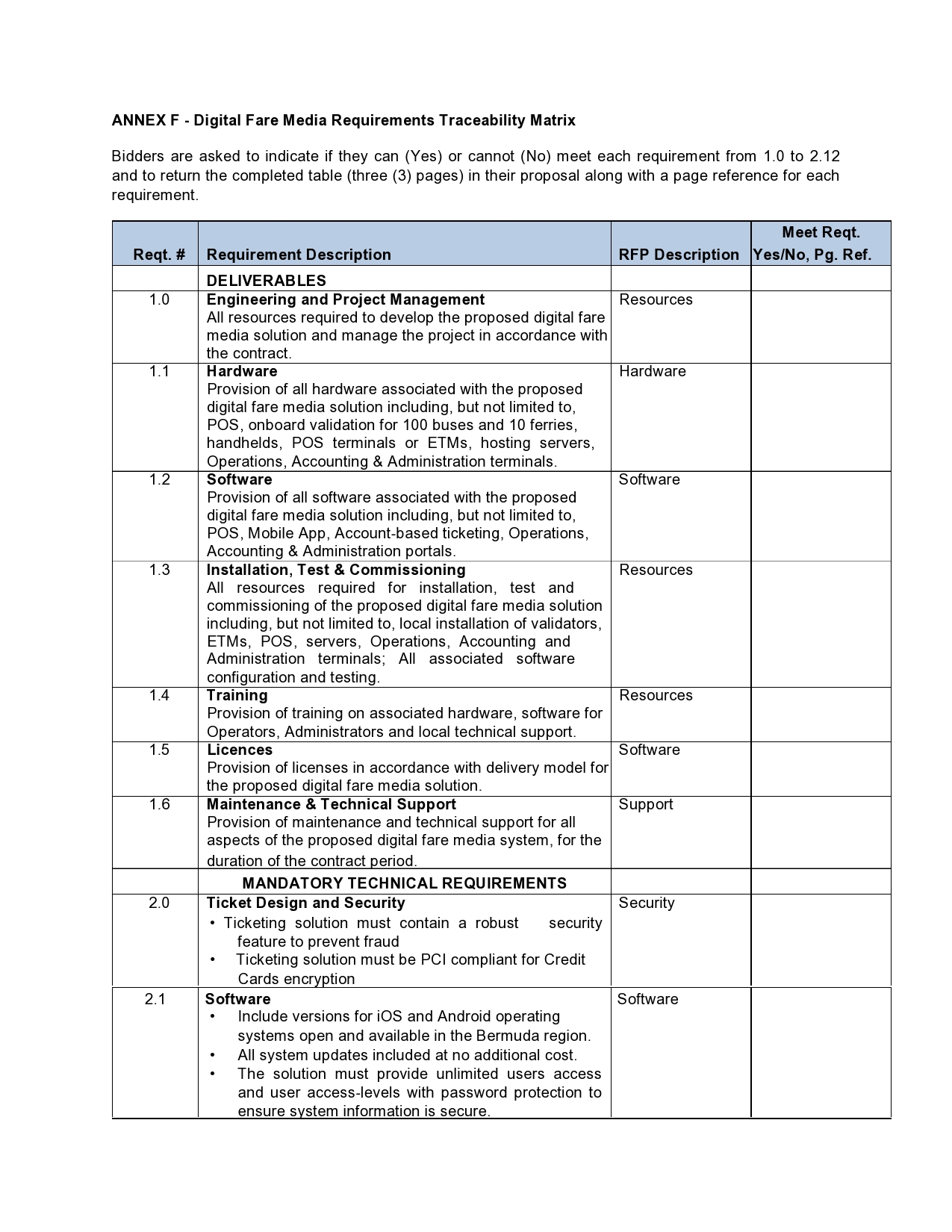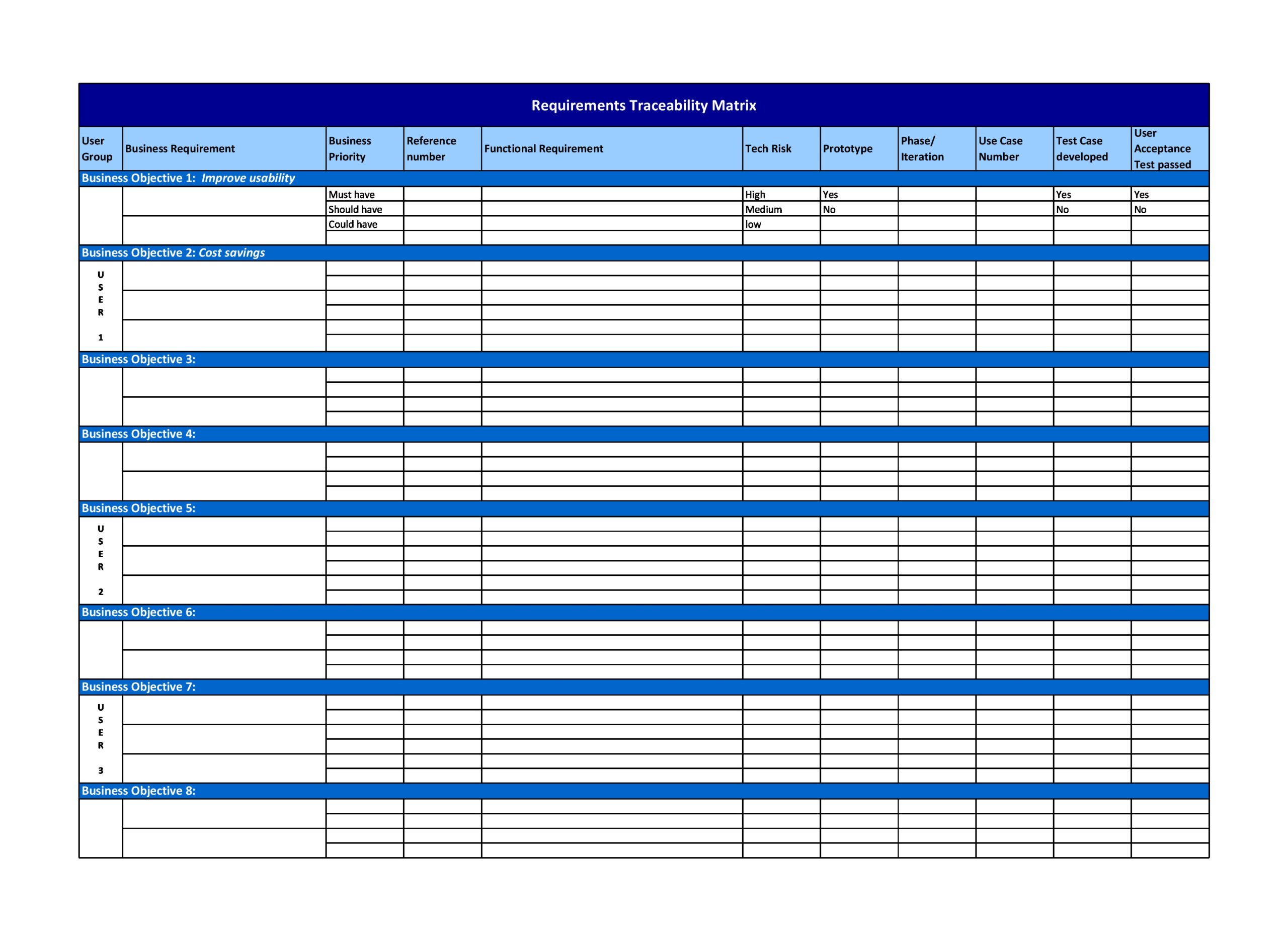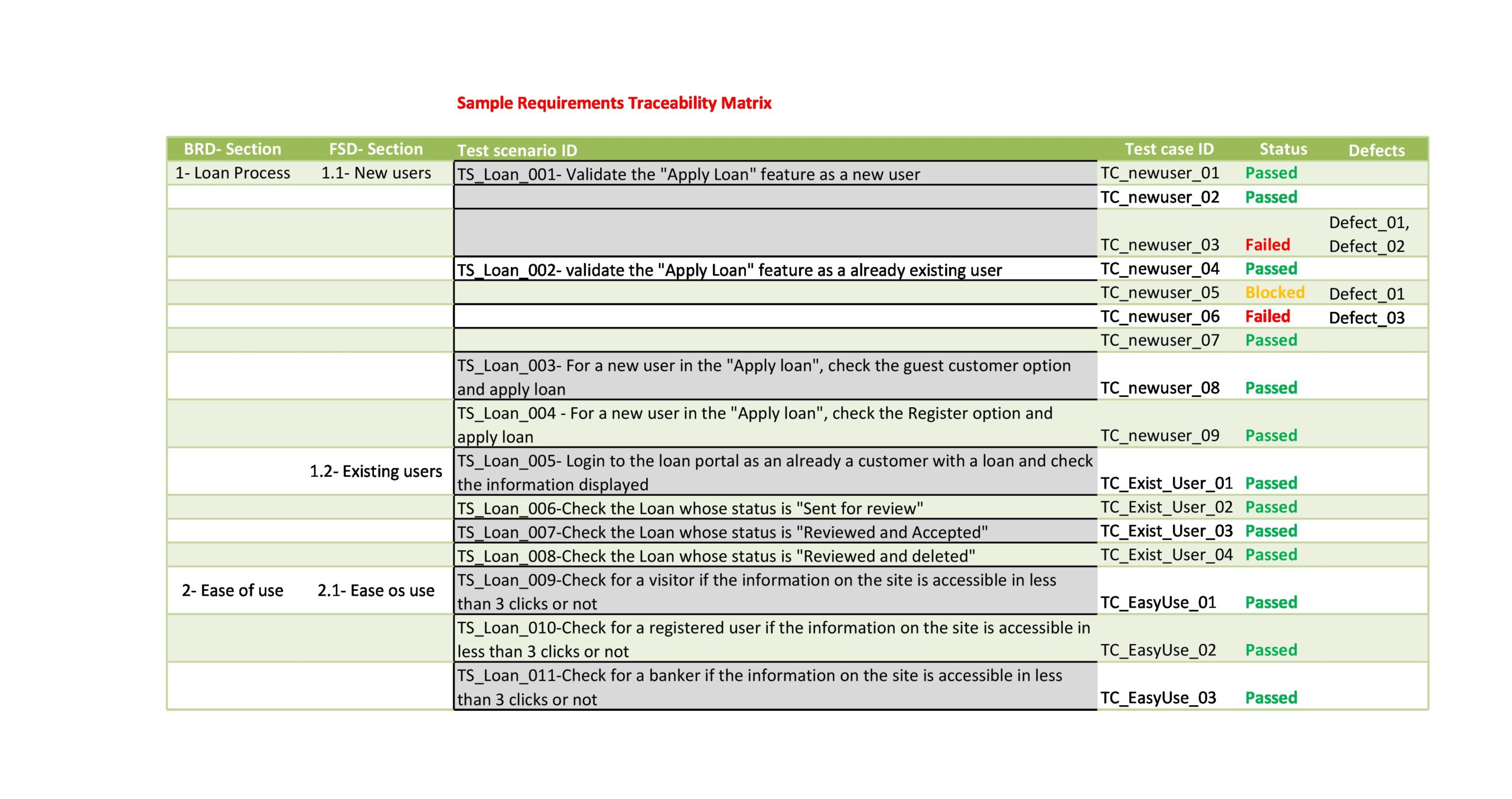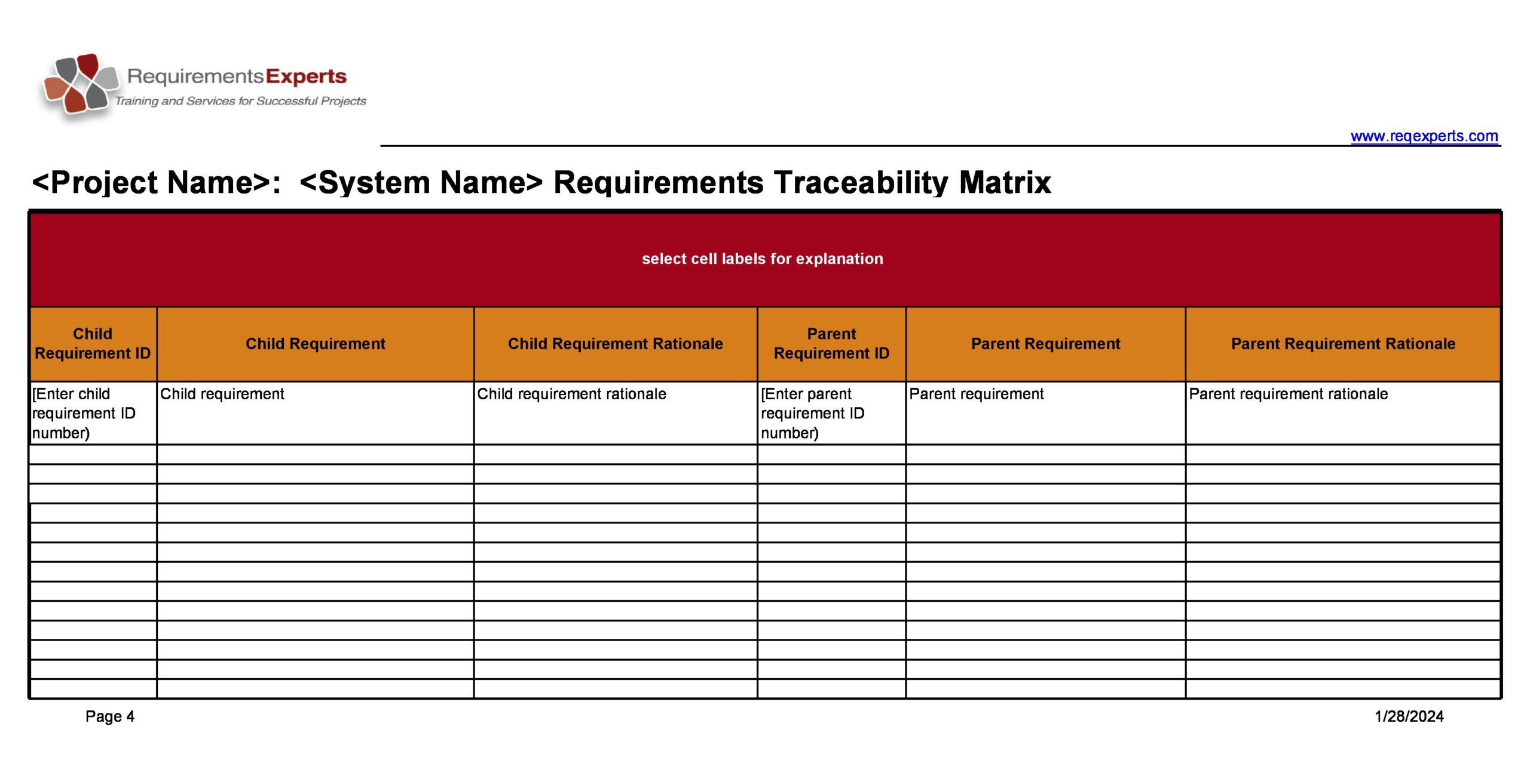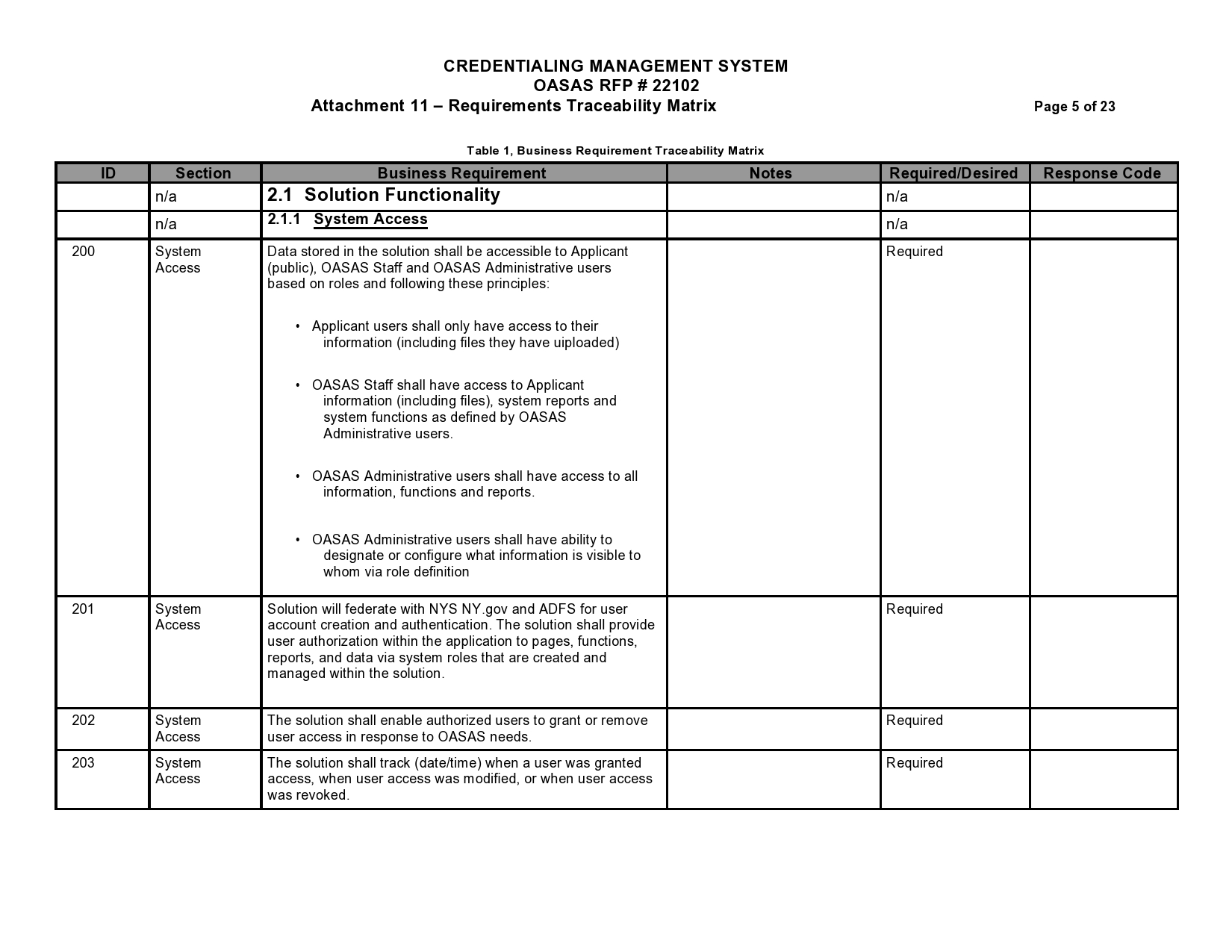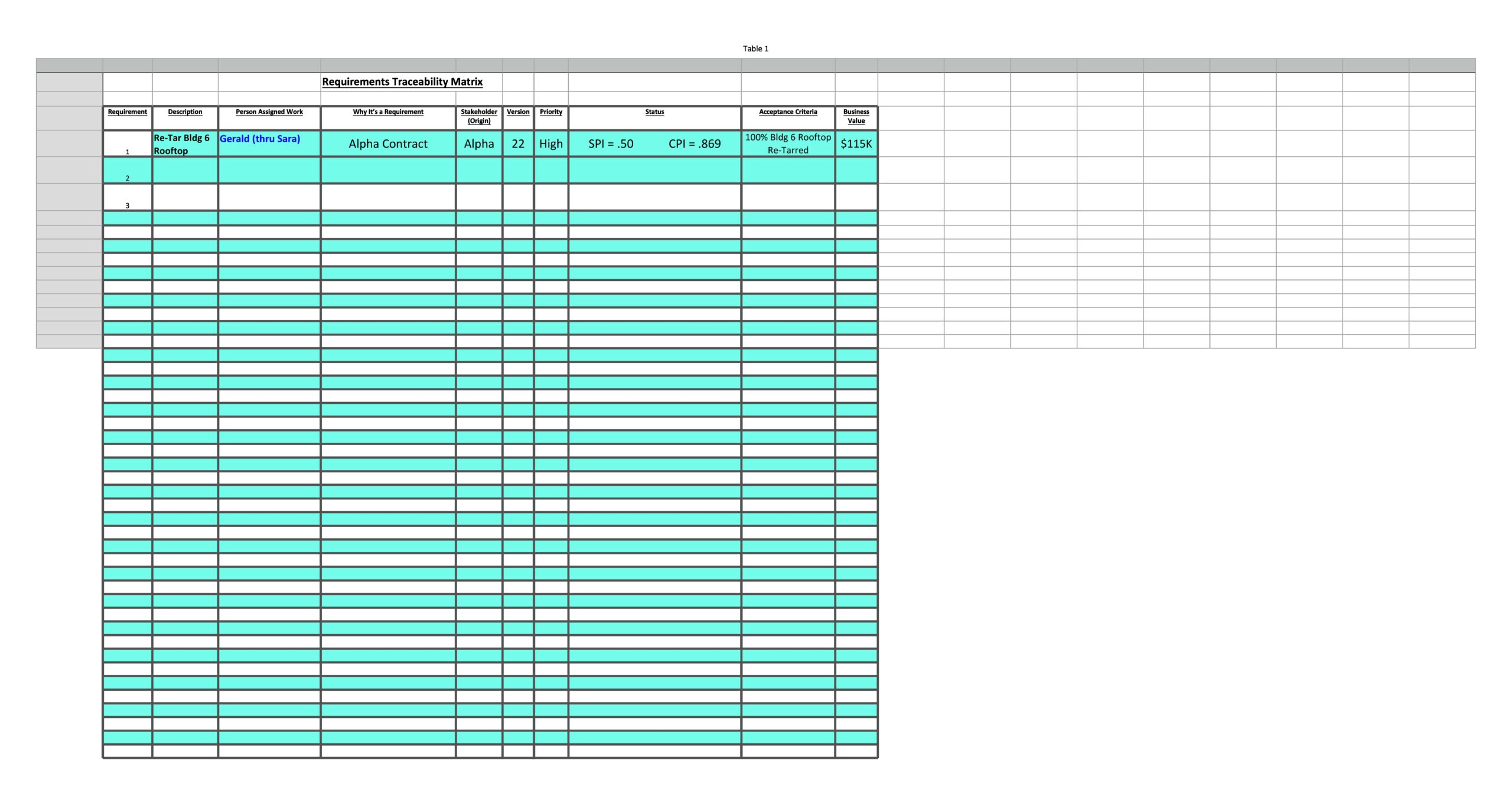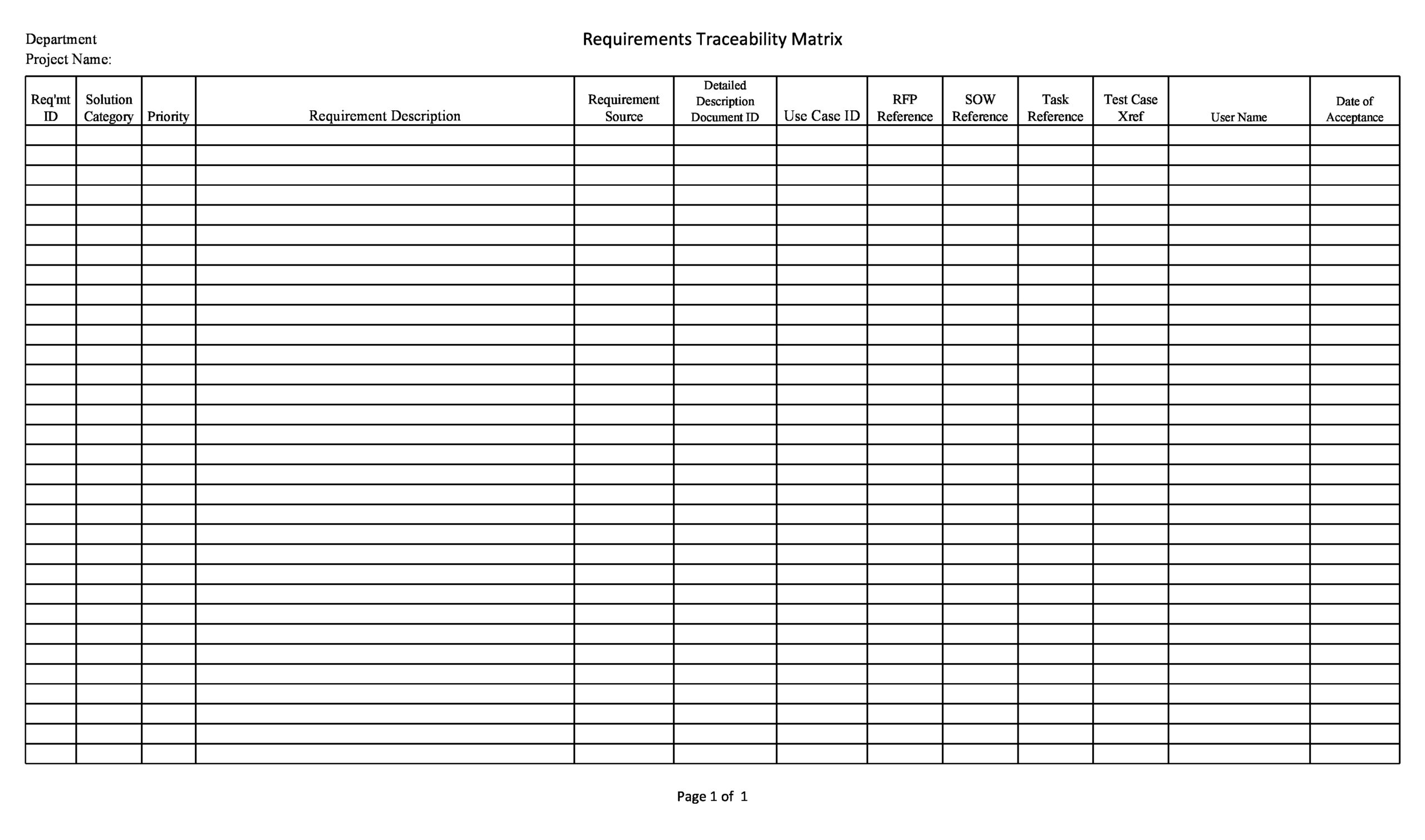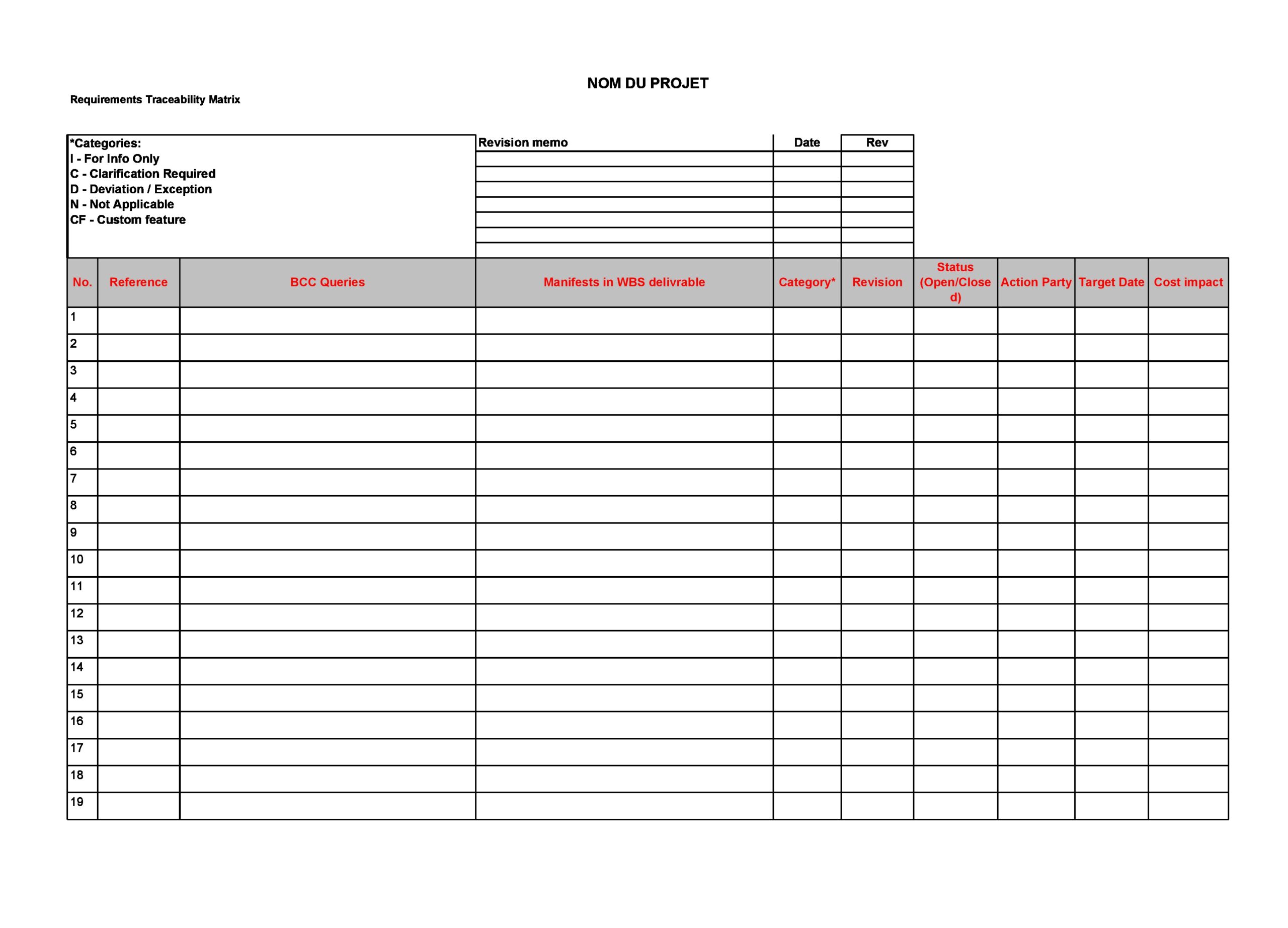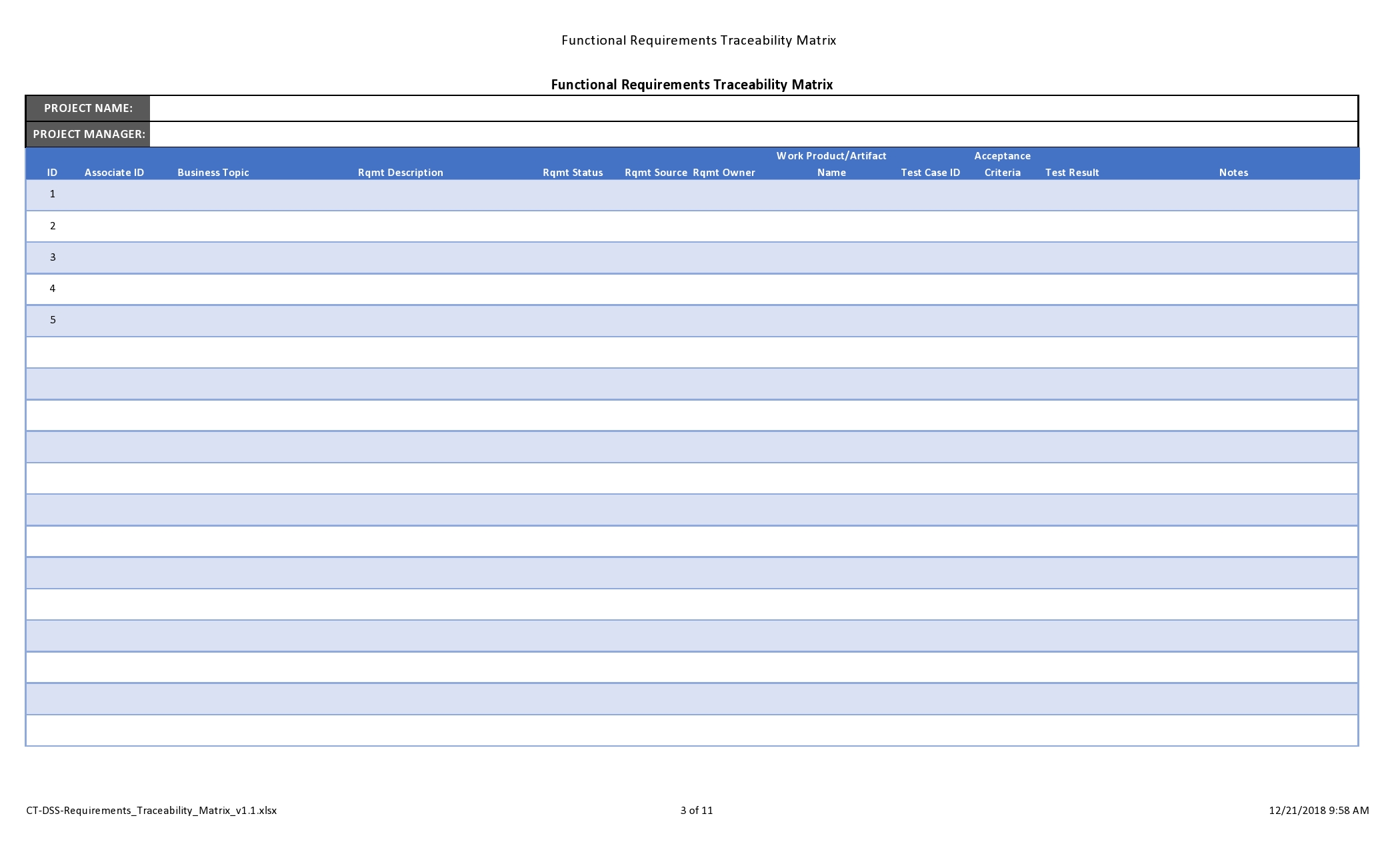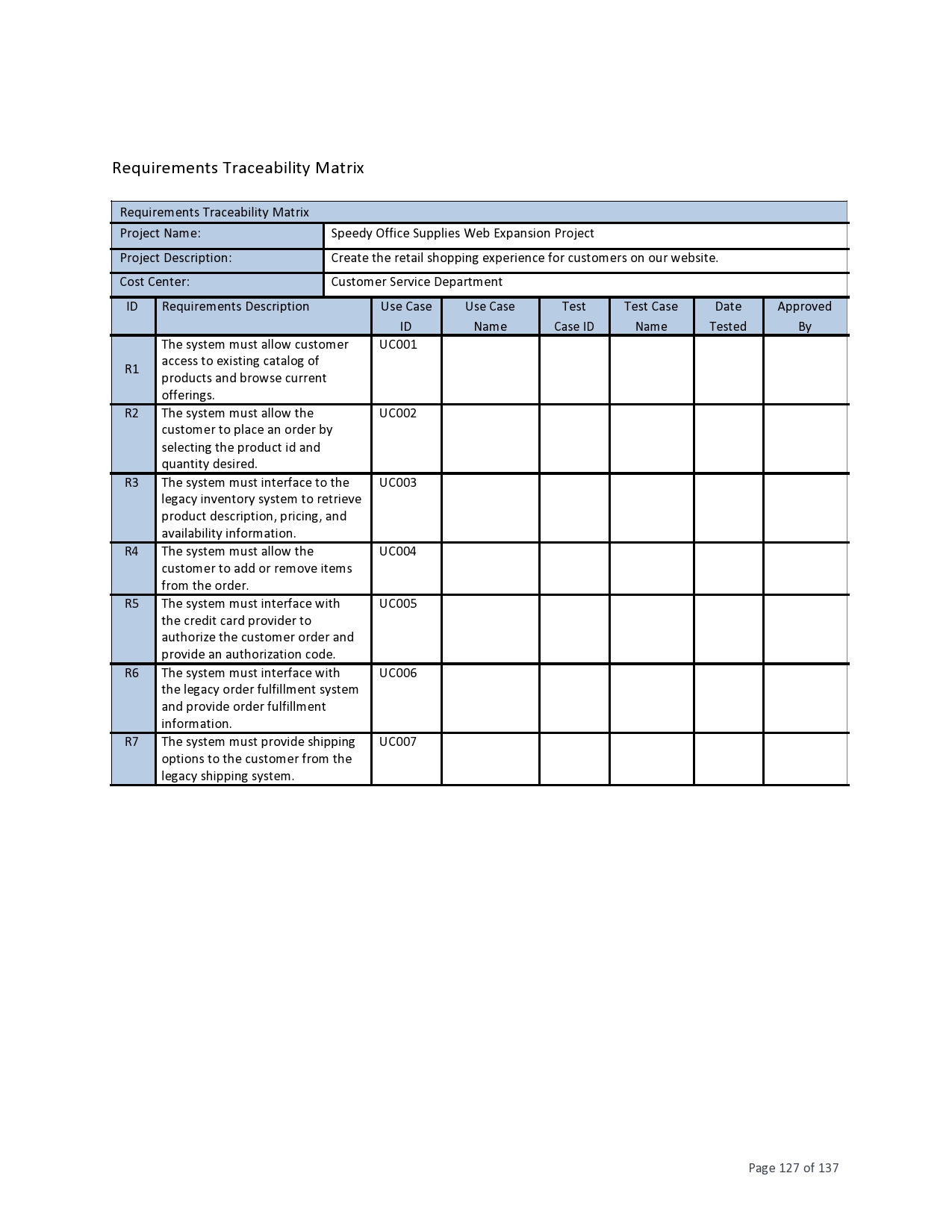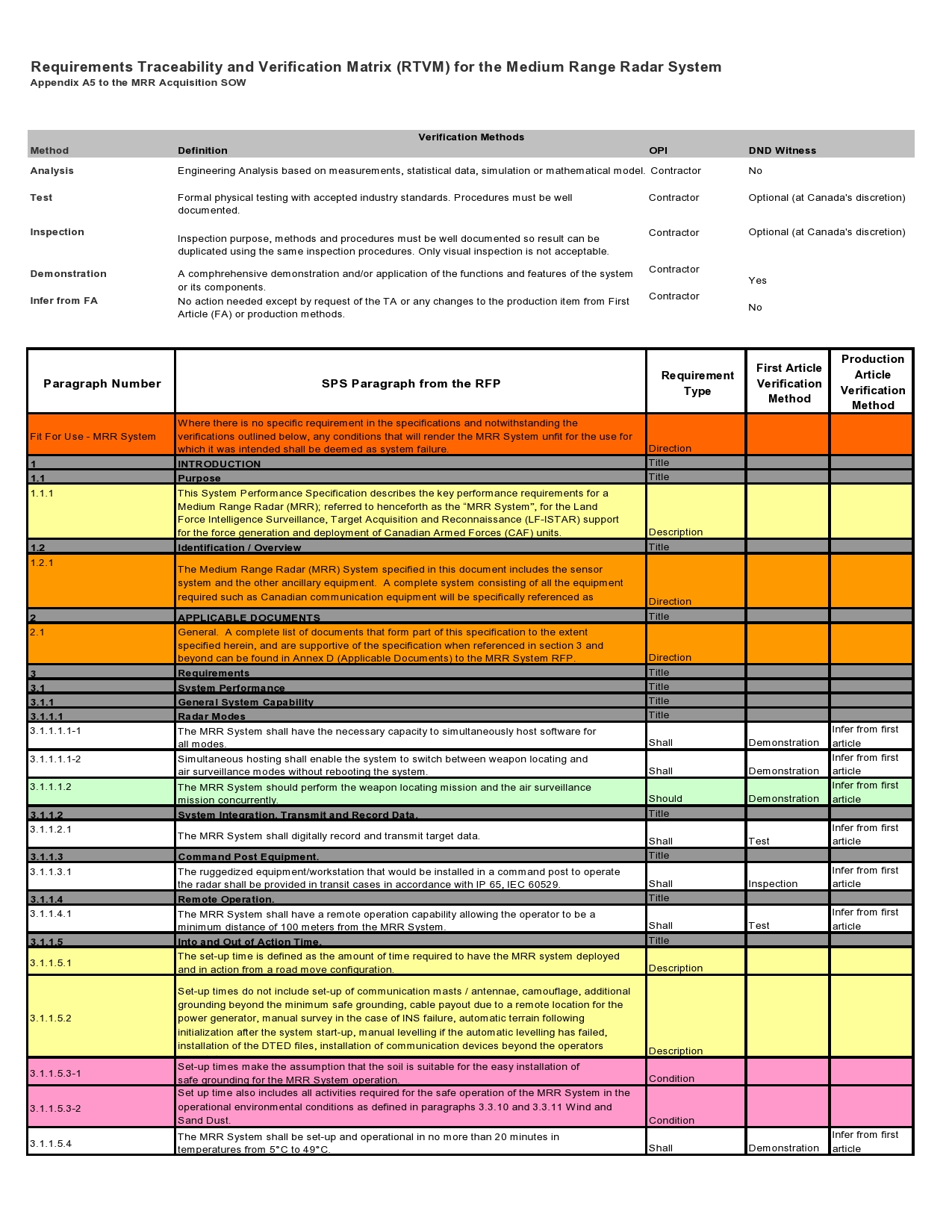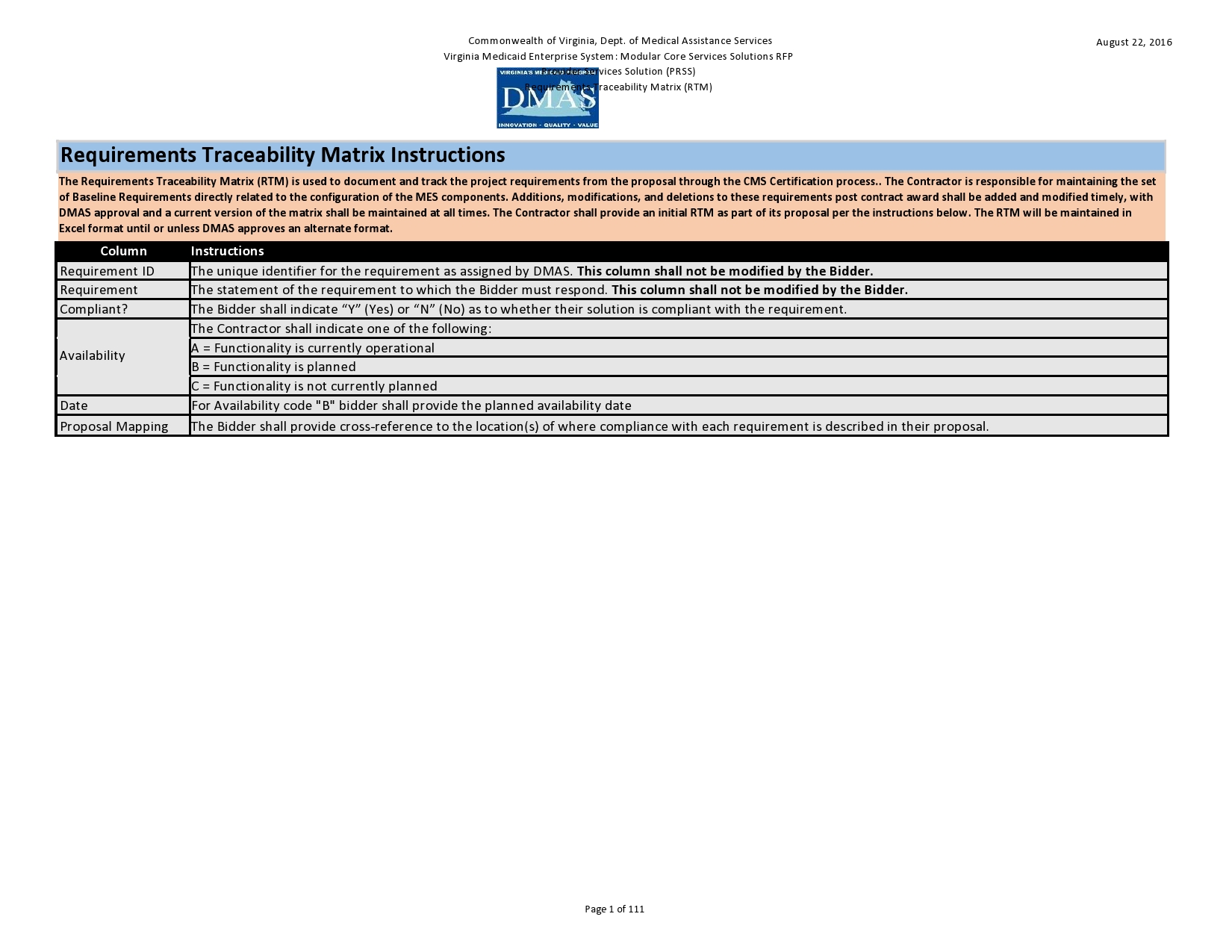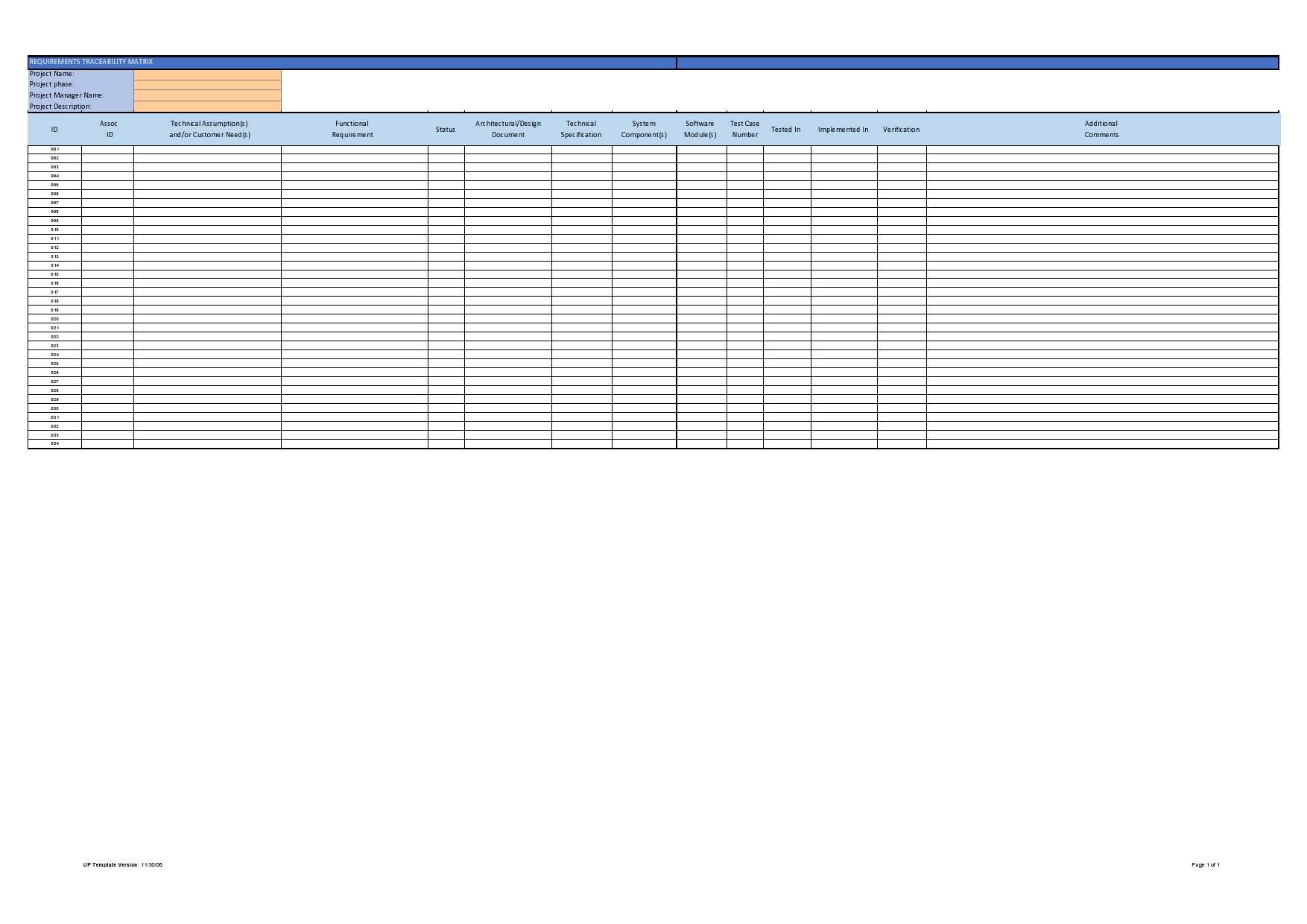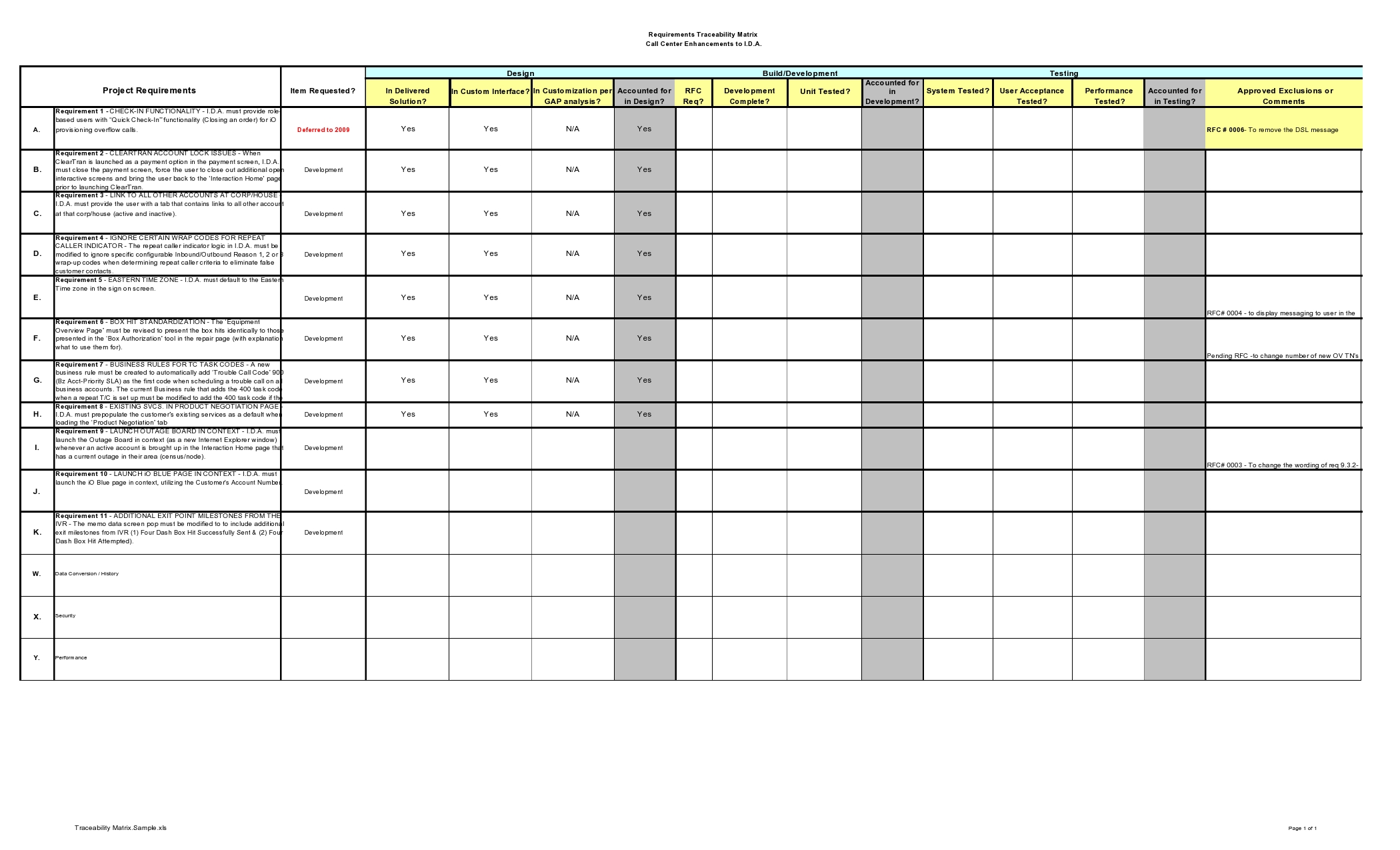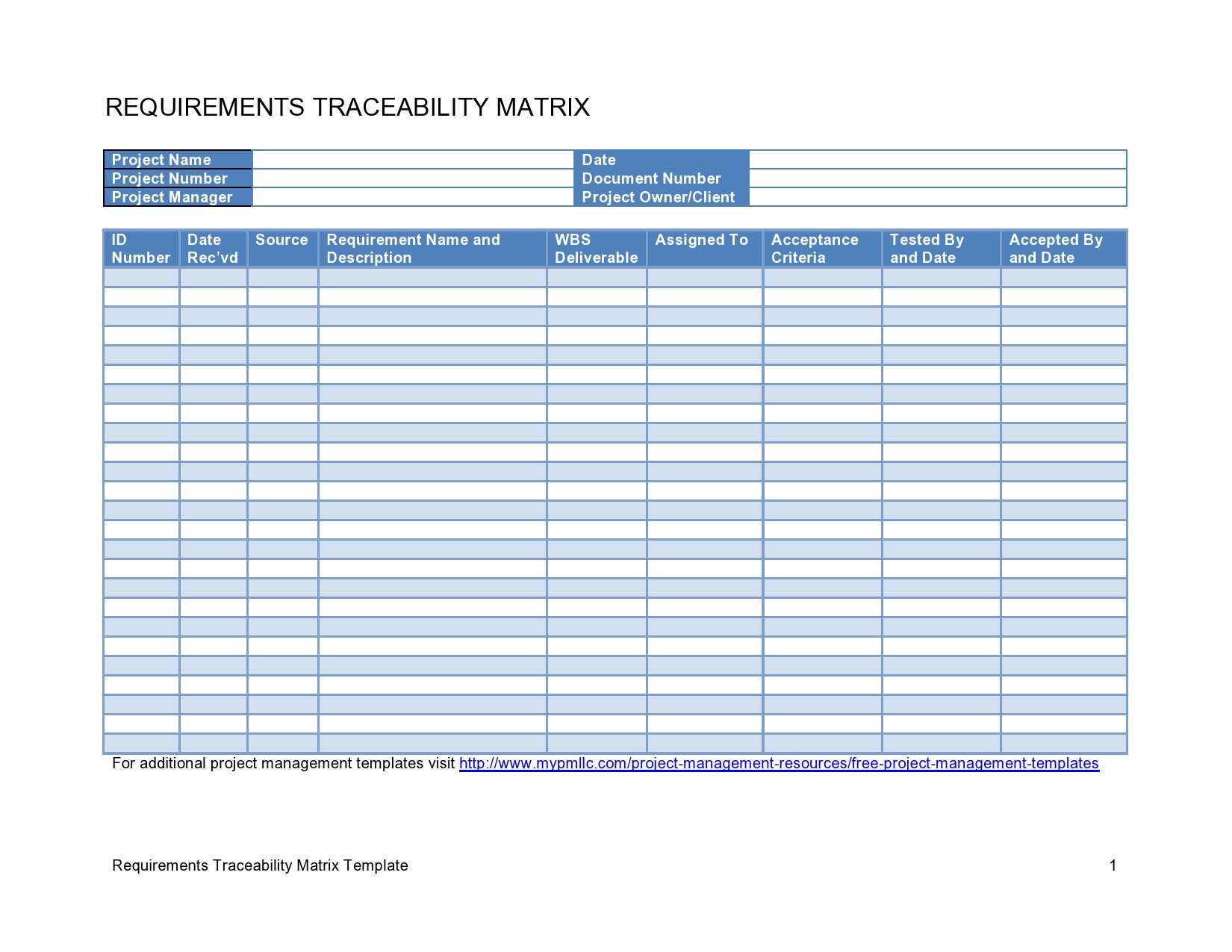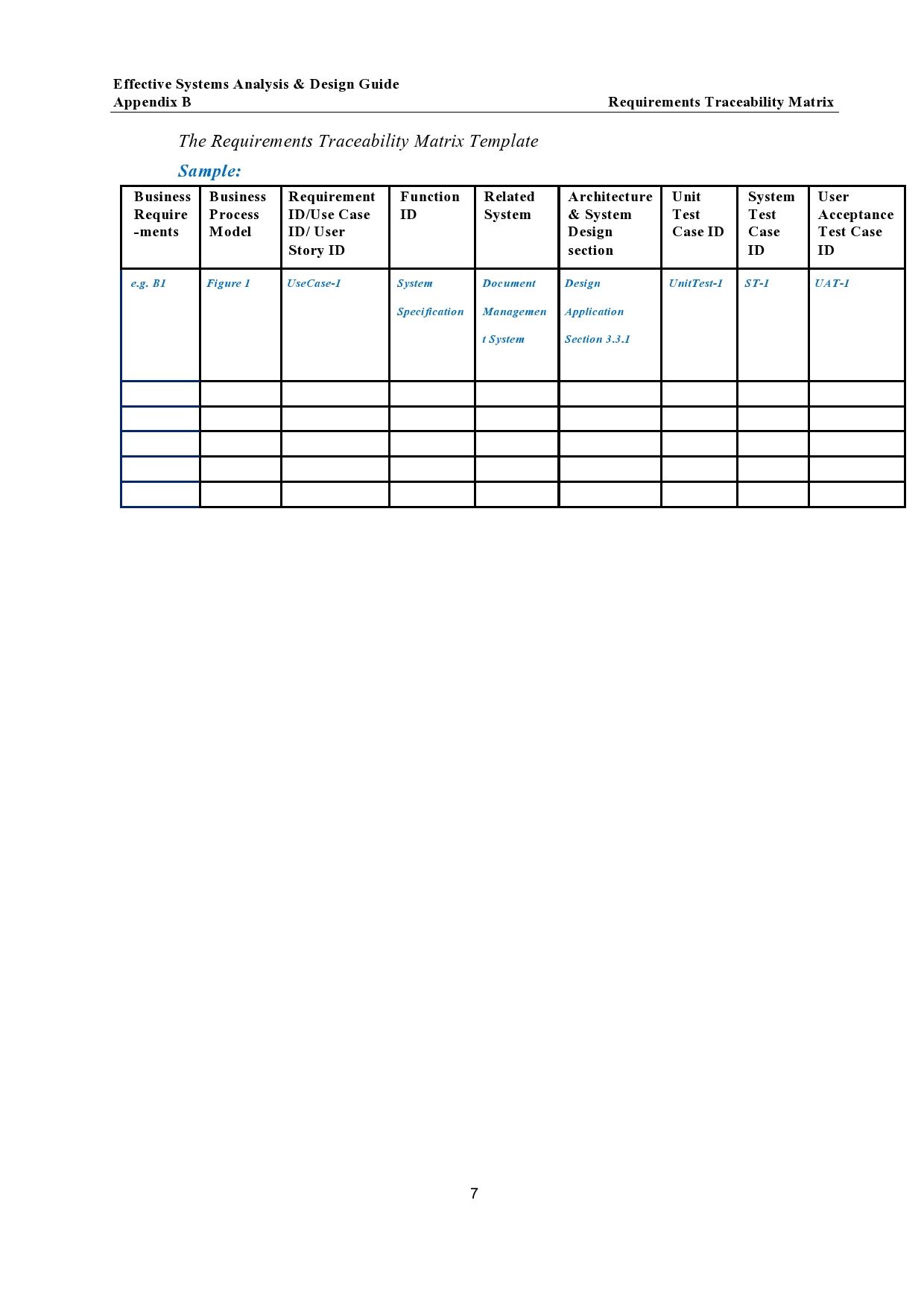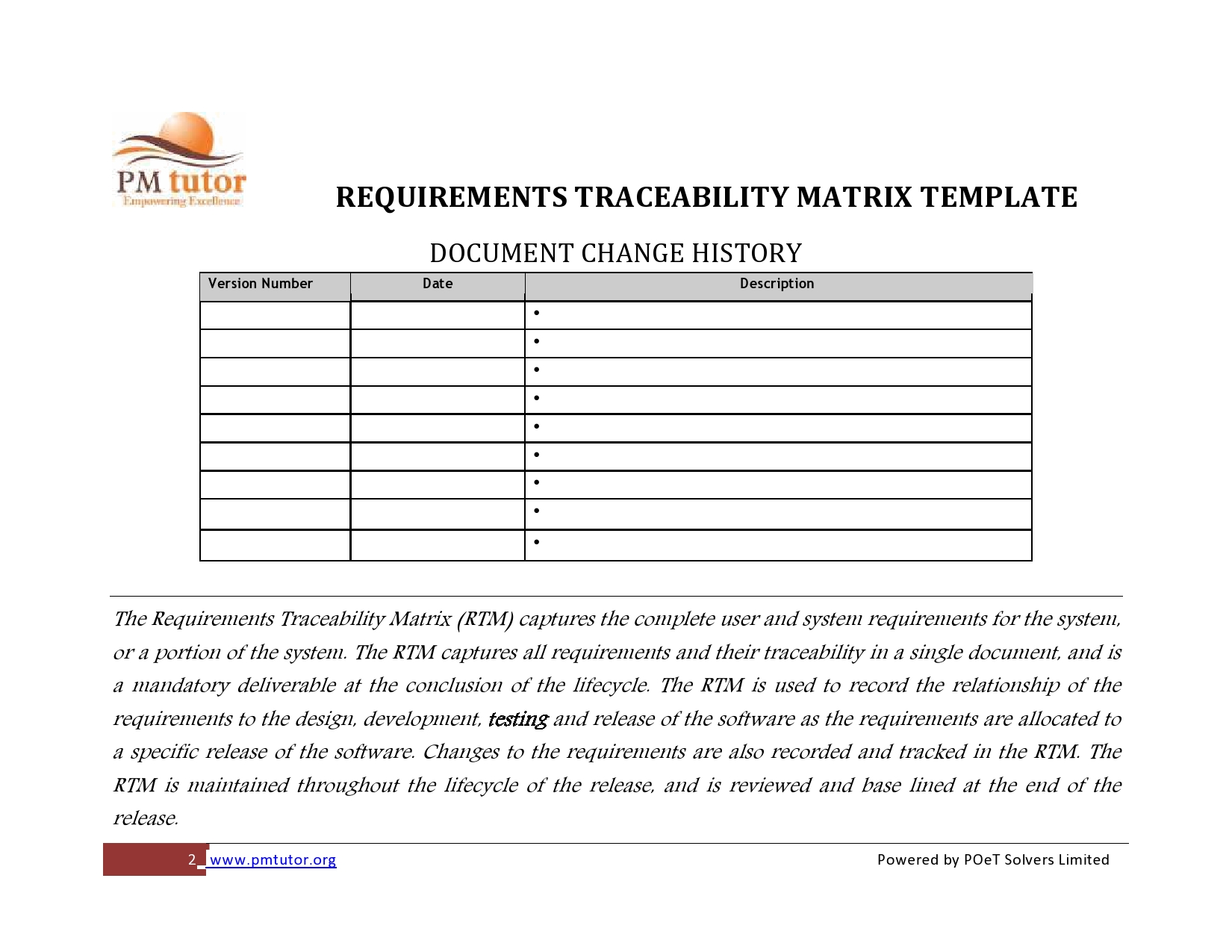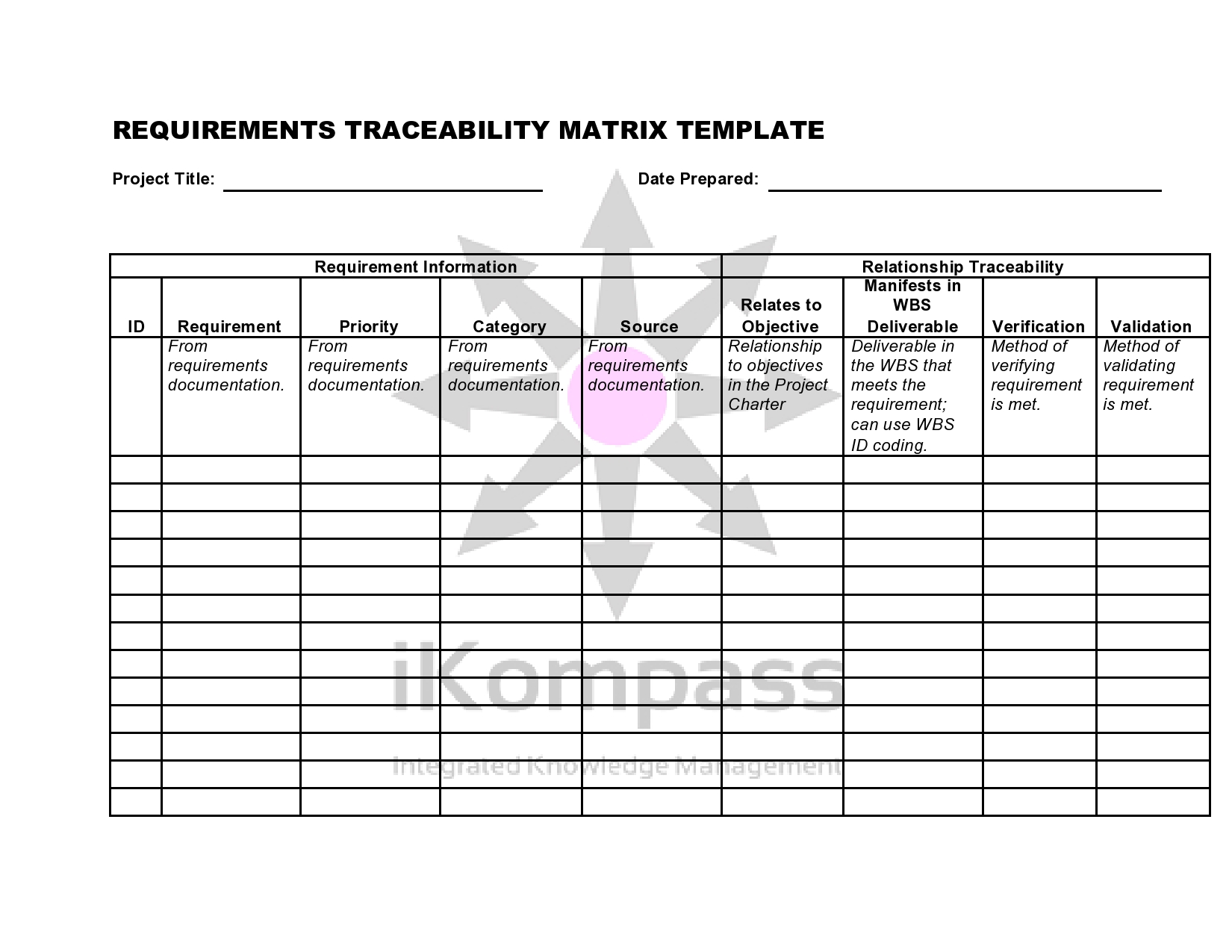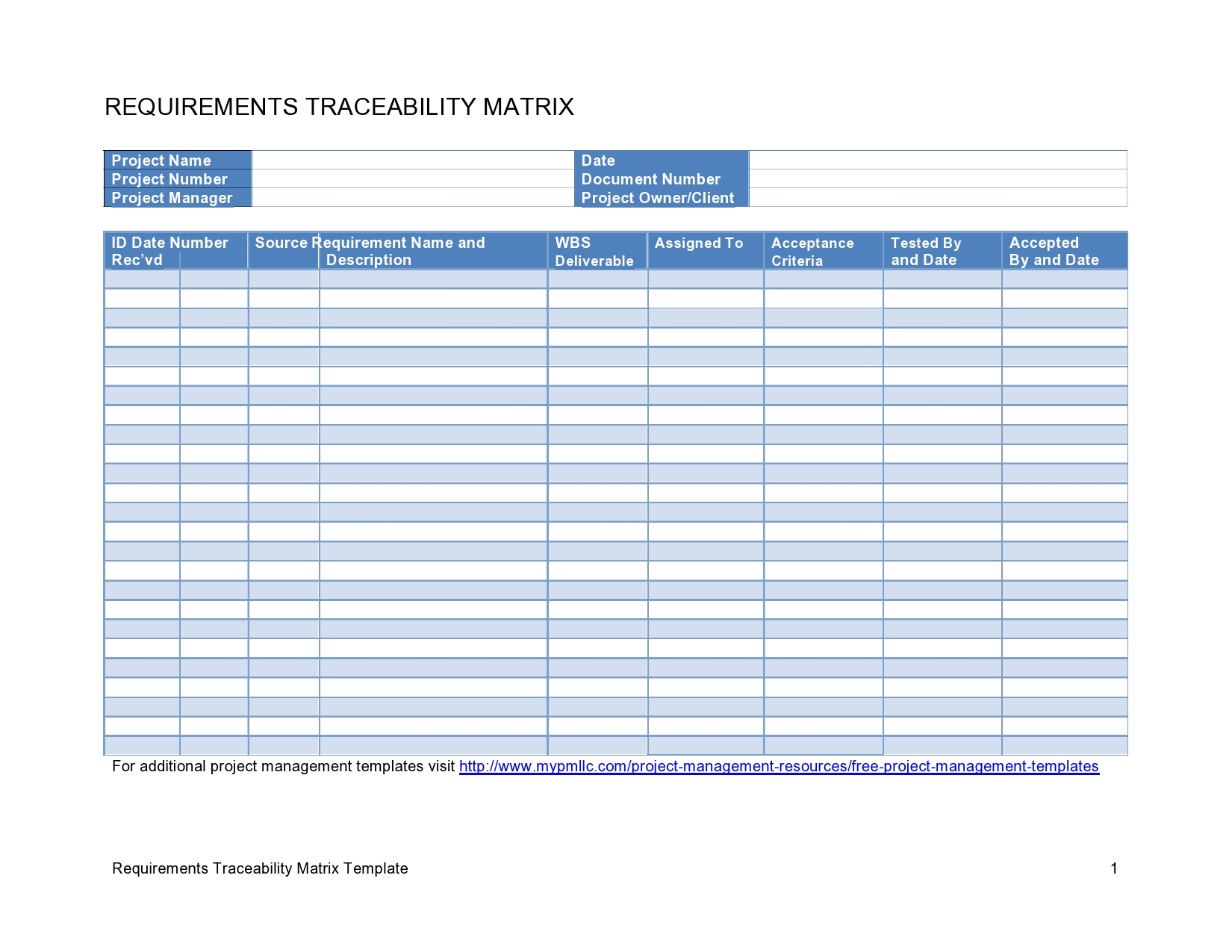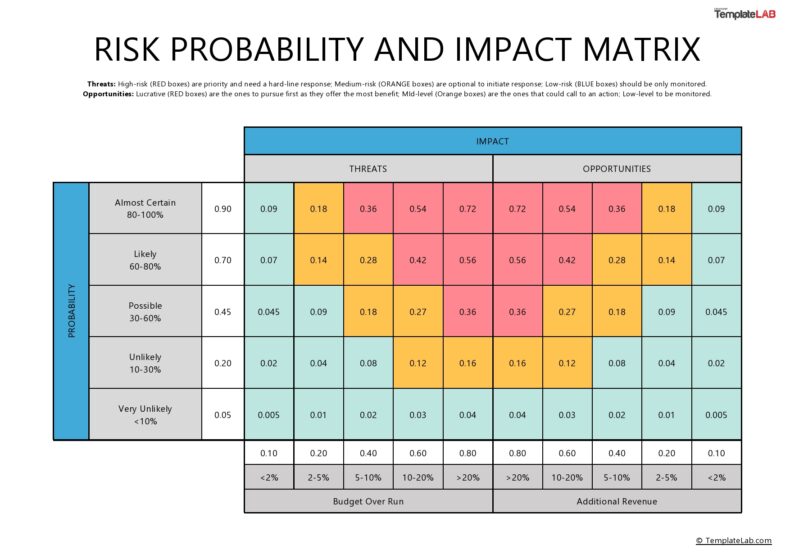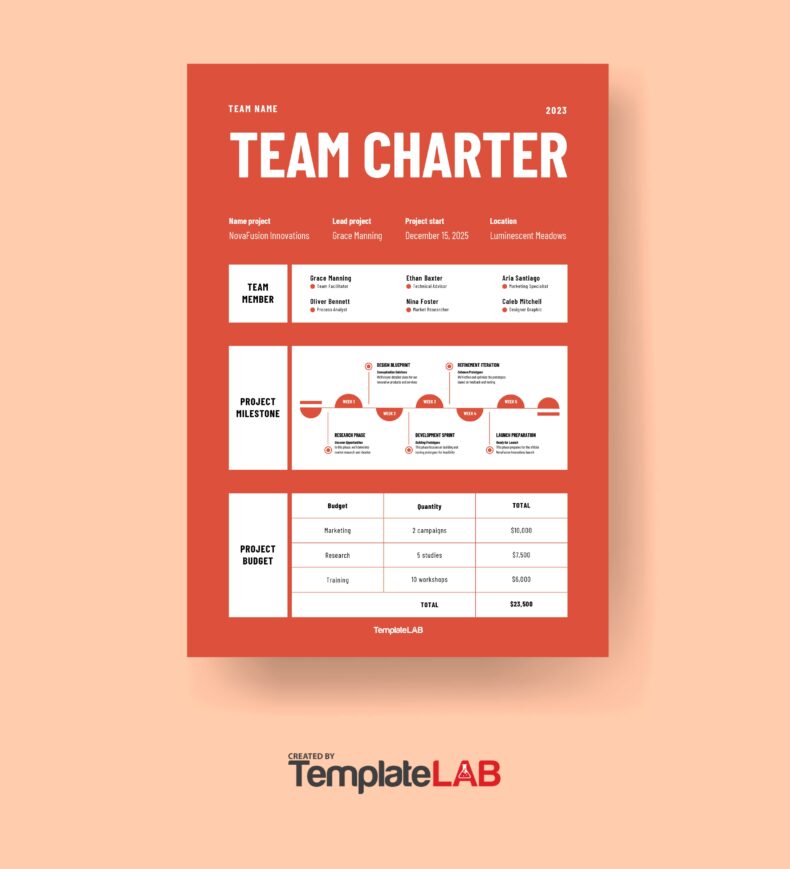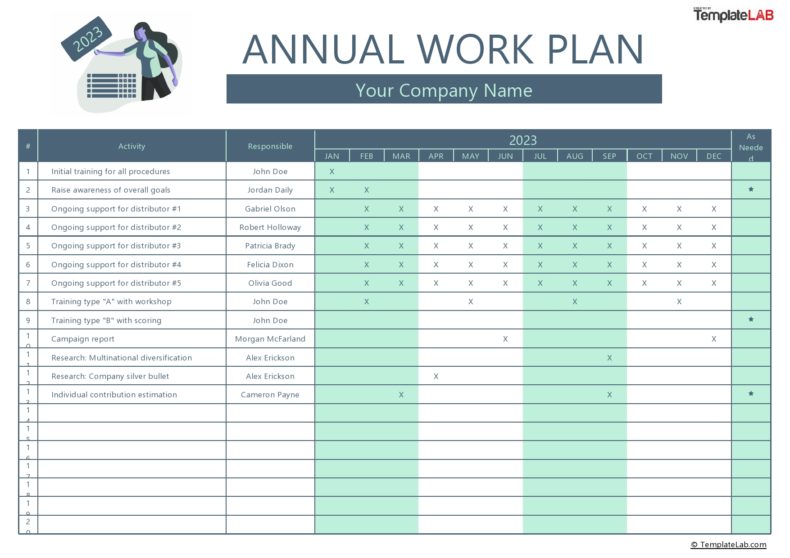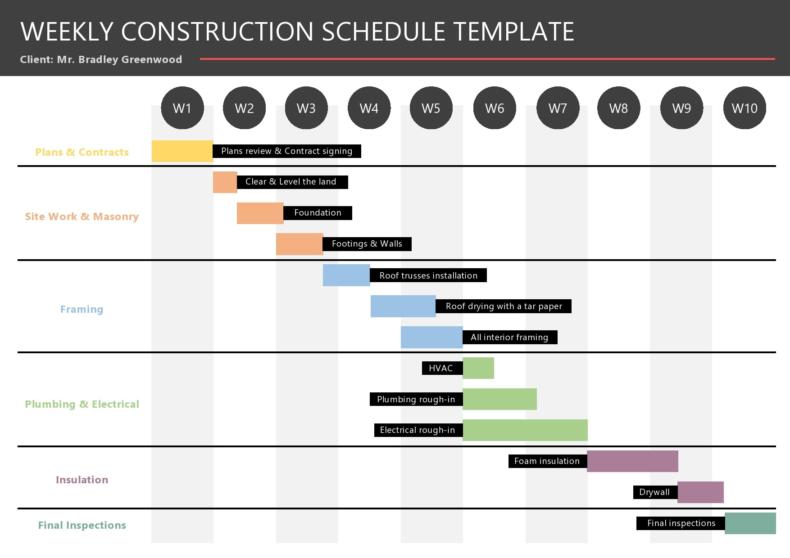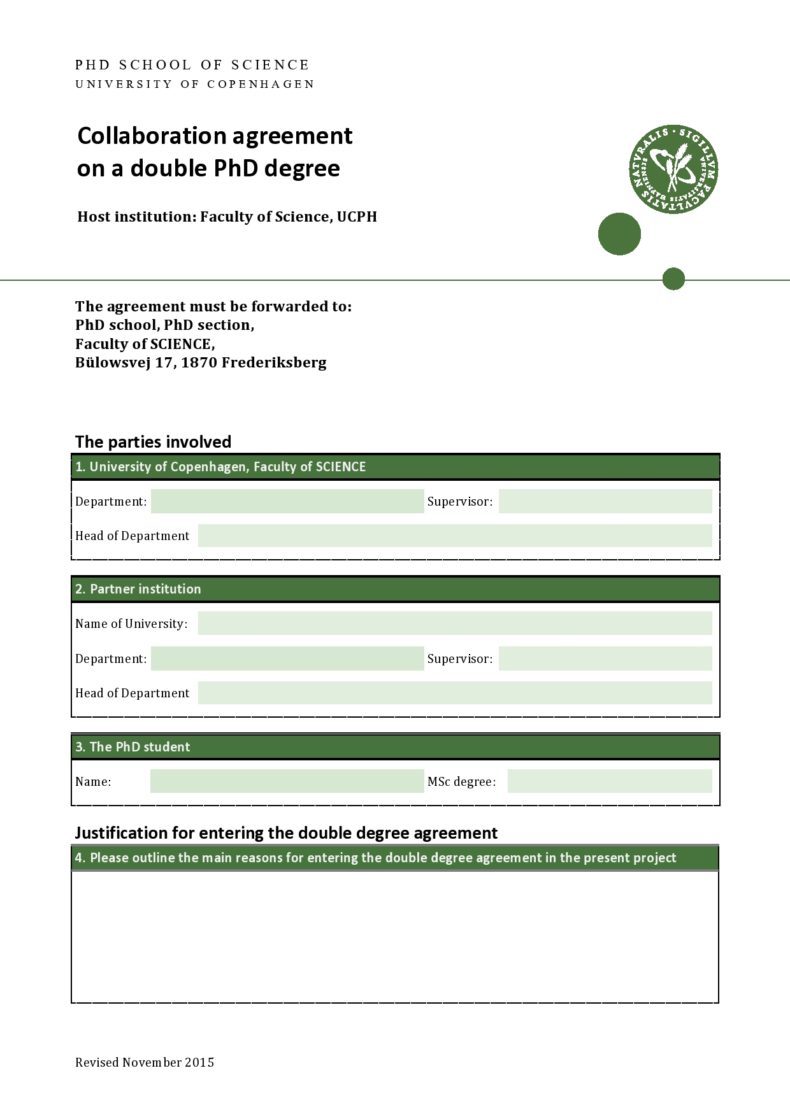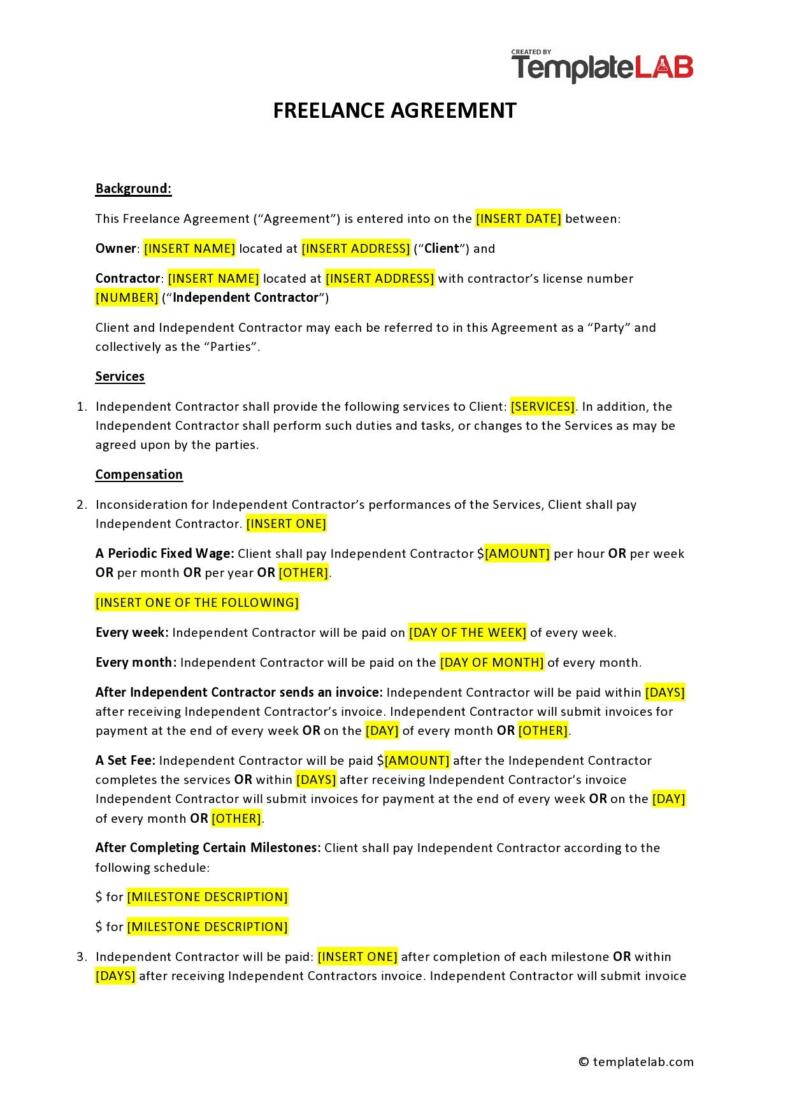Major and minor projects go through different lifecycles. The project management team needs to keep clear project progress records for each phase. The records may include reports from the testing process such as software testing. A traceability matrix ensures monitoring of the project progress is done the right way.
Table of Contents
- 1 Requirements Traceability Matrix
- 2 What is a traceability matrix?
- 3 Requirements Traceability Matrix Templates
- 4 What are the 3 major components of the traceability matrix?
- 5 Requirements Traceability Matrix Examples
- 6 What benefits does the traceability matrix offer?
- 7 Why do we need RTM?
- 8 Requirements Traceability Matrix Samples
- 9 What should a requirements traceability matrix template include?
It allows the concerned team to confirm that the testing process followed due procedures. The traceability matrix lets the quality assurance team confirm the software testing was done correctly. It is useful for managing the requirements in every phase of a project. It acts as a guide that connects the various project components and guarantees that every prerequisite is satisfied.
Requirements Traceability Matrix
What is a traceability matrix?
A requirements traceability matrix template is a document that links project objectives and other elements. It serves as a link offering a transparent route for tracking project management needs from the inception to the end. It allows consistent verification of the technical requirement document throughout the project phases.
It is a business requirement document leveraged by a project management team to monitor everything needed in the project throughout its duration. Many managers consider the requirements traceability matrix template as a roadmap. It allows teams to understand and monitor every part associated with the project.
They use it to compare the deliverables with the original details of the project. When project management delivers the business requirement document with everything needed, it strengthens relationships with the project owners. The technical requirement document must include the details as expected by both parties.
Requirements Traceability Matrix Templates
What are the 3 major components of the traceability matrix?
The requirements traceability matrix example is important for letting teams learn the expectations of a project. It is an essential tool for keeping the scope of a project under control. The forward traceability document ensures there is smooth communication informing the relevant people about what has been done in every phase.
It is crucial to understand the major components of a requirements traceability matrix template. It guarantees sustained transparency throughout the project cycle. Bidirectional traceability ensures there is clarity about what has been done as per the project terms. The major forward traceability components include the following.
- Project management status
A traceability matrix should include a report of project management status. It is a summarized report presenting the current situation of the project currently. The traceability matrices evaluates the initial requirements and the advancements of the project using the benchmarks specified in the contract document. The major components of a status report in a requirements traceability matrix RTM may include:
A tracking performance report. Performance tracking is a report that validates all requirements. It ensures they have been executed accordingly. The report also highlights any pending issues.
A report of project conditions. This report provides an overview of the health of the entire project. The report helps project owners have an idea of whether the project is going in the right direction.
The project needs a report. The document needs to communicate any project life cycle issues that might need further attention or funding. - Project requirements
In a requirement traceability matrix, project requirements are data that illustrate and support the specific needs of the project. The data must explain whether the resources available are meeting all the requirements for the progress of the project. The main point discussed in the requirements traceability matrix example may include the following.
A detailed list explaining the project specifications and what is needed in each item. The specifics may include technological and functional needs.
Essential information on issues that must be handled to help the project progress. This report should provide an all-inclusive database that guarantees no necessity is missed.
The report should give each need a special code that makes it easier to track it no matter the progress of the project. - Forward traceability
The report should offer data that makes it easier for anyone to trace each product component with ease. They should be able to get a quick view of the entire project whether it is the issue of raw materials, shipping, coding, and every there detail. The traceability matrix may feature the following.
Explain how the current project components are linked to other project components. The requirements traceability matrix example may feature things such as the source code of the project. It may explain the design documentation and test cases. It should allow stakeholders to understand the project’s progress in detail.
The report should allow stakeholders to examine the potential effects that modifying one area of the project might bring to the other area. It should support well-informed decisions. The bidirectional traceability report offers an overview of the project benefits of the different components.
Requirements Traceability Matrix Examples
What benefits does the traceability matrix offer?
A requirements traceability matrix template makes it easier to find any gaps in the functionality of the project. It allows stakeholders to view all the unimplemented features. Because it guarantees full test reach, it ensures all modules and combinations of the project have been tested. It allows monitoring of the entire progress of the projects to meet business requirements. The requirements traceability matrix offers many benefits.
- Allows managers to manage project risks
Projects face different types of risks that could slow their progress or impact performance. Some of the risks are associated with costs, schedules, or performance. A bidirectional traceability plan allows managers to find gaps or any discrepancies in the project requirements. It helps them solve problems early before they cause serious problems in the project.
Forward traceability lets managers evaluate changes that have occurred in the project over a given period. Using the project requirements matrix, they can analyze the changes and determine their impact on the project. This way, they make decisions based on information. - Increases effectiveness in project monitoring
A requirement traceability matrix allows the monitoring of projects in real-time. It makes it easier for managers to track the project development and progress closely. Due to this, they can make proactive decisions promptly. They indemnify the areas that require quick attention to allow project progress.
A requirements traceability matrix RTM is also useful in reporting. It functions as a tool for documentation. Project managers use the document to offer a thorough record of the project’s current state and how the components are interconnected. - Improves communication between parties
A requirement traceability matrix offers a detailed summary of how the project needs to connect with its other components. It provides clear information that any stakeholder can access and get an overview status of the project.
Due to this, the requirement traceability matrix guarantees smooth communication among teams. It enhances cooperation where all project participants have access to a single traceability matrix. It allows them to effortlessly monitor the project advancements and their reliability. - Promotes customer satisfaction
The requirements traceability matrix template aligns project needs with expectations. It ensures the finished project closely complies with what the customer expected. Since there is a greater likelihood that the given solution will satisfy all requirements, the project requirements increase customer satisfaction.
The requirements traceability matrix RTM keeps a ready-to-view record of how the project is progressing. The client can view what new things are developing and the changes made. This allows them to have confidence about the project’s success. - Promotes flawless quality assurance
Quality assurance tests need to be made throughout the project cycle. The requirements traceability matrix RTM makes it easier to validate and verify requirements. It ensures every requirement is checked and lowers the possibility of having a poor-quality project.
The project requirements plan provides an audit report that makes it easy to examine and confirm that the project complies with every requirement. This type of report is especially necessary in fields where project management and reporting are regulated.
The benefits of a traceability matrix go above the simple documentation process. It allows enhanced project management and promotes teamwork. The document helps lower project risks which improves its success.
Why do we need RTM?
A requirements traceability matrix is a useful document in projects involving software development. It is used to confirm that every requirement gets connected to every test case.
The traceability matrix is mainly leveraged by project managers to ensure the teams consider all project aspects during the testing phases. Project managers need a requirements traceability matrix example for different reasons.
- Constant enhancement of the project
The requirements traceability matrix example offers insights into any project difficulties or successes. The team can see whether the standards are satisfying expectations or not.
Due to this, the traceability matrix supports a culture of constant project enhancements. It provides teams with morale to look at the trends and pinpoint areas that need improvements. - Makes the processes clear and understandable
The requirements traceability matrix ensures that everyone in the team is aware of what the project needs. The document acts as a single source of reference and clears any misunderstandings.
It encourages consistent application of the right criteria throughout the project cycle. The client’s needs may change from time to time. If changes happen, the requirements traceability matrix makes it simpler to effect the changes. - Ensures resources are allocated effectively
The requirements traceability matrix template makes it easier for project managers to manage resources. The documents help them see areas that require more human or technological input. Through effective distribution, all project phases run smoothly.
This way, the project gains sufficient ability to meet the needs of the customer. It guarantees the finished project satisfies the expectations of the customer. A requirements traceability matrix template adopts a customer-focused strategy that raises satisfaction. It boosts the possibility that the project will succeed. - Inspection to validate project quality
The requirements traceability matrix is often used as a tool for validating the inspection procedures. It guarantees that all requirements are correctly carried out. The requirements traceability matrix ensures all tests are done the right way. The report increases trust and ensures the project increases in quality in every phase.
The document offers a continuous access point of information. It lets them add their contributions to be considered for the larger project outcome. This type of openness encourages teamwork. It minimizes the possibility of miscommunication. The traceability matrix is designed to ensure the customer is happy with the processes of the project. - Provides a detailed record for audits and compliance
Having a detailed record from the start to the end of a project is essential for auditing purposes. In fields such as financing and insurance, developers must adapt to stringent regulations.
The requirements traceability matrix becomes a record that can be trusted. It demonstrates how each need is handled and verified. It offers proof of compliance with guidelines.
Requirements Traceability Matrix Samples
What should a requirements traceability matrix template include?
Creating a requirements traceability matrix requires following the proper structure. It requires the manager to identify the monitoring requirement as the project progresses. The important features that must be included in the document may include the following.
- Create a unique identifier for every project requirement. The ID could be numbers, letters, or a combination of both.
- Offer a detailed explanation of what should go into each requirement. This allows the entire team to know the project scope and limits. A developer may request customer feedback as one of the requirements.
- Create several segments dividing the categories based on their functionalities and human or technical needs.
- Create a list of all need-based dependencies. Show how they are interconnected. It makes it easier for the team to see how one issue is connected to the other.
- Offer a comprehensive detail of the status of the project at the moment. You might include information such as whether the project is underway or financed. Indicate whether it is conforming, on hold, and so on. In simple terms, the requirements traceability matrix template the client quickly understands its status by simply looking at the document.
At one point or another, there could be various changes made to the project. The customer should be able to view all the changes chronologically. Providing details of the change history allows the client to trust the results.
The entire requirements traceability matrix needs to be updated regularly. It should the current project status while availing historical data at the same time. It makes tracking and managing the project simple.

